Metro Exodus performance analysis: RTX, ray tracing, and DLSS benchmarked
Exodus is the second game with ray tracing support, with DLSS to offset the performance hit. We've got benchmarks and image quality comparisons in this performance analysis.
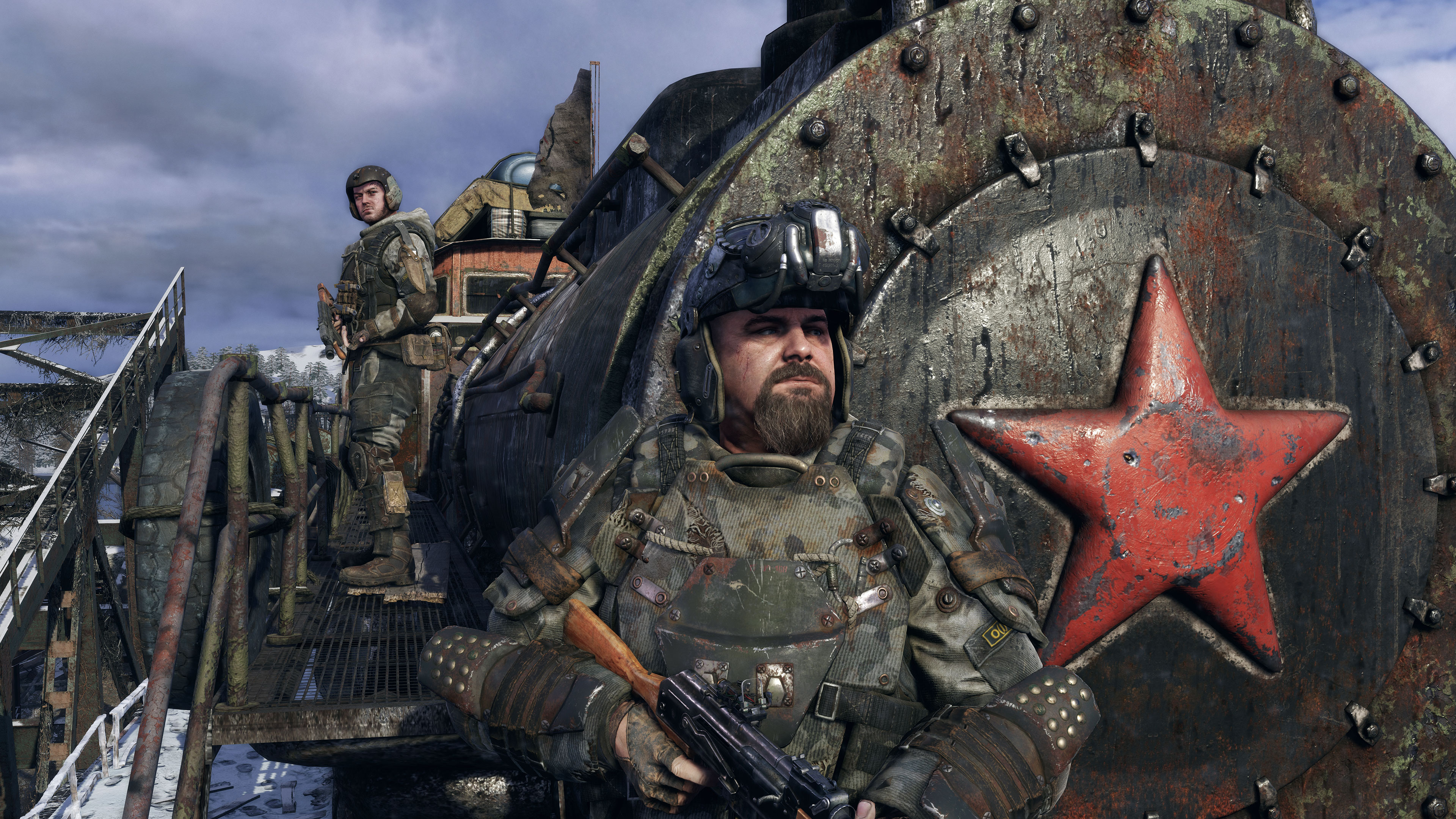
Nvidia's GeForce RTX cards have been a target for criticism since they launched last year, and while the RTX 2060 finally brings pricing down into the potentially affordable range, at $350 it's still a high-end card. With only one ray tracing enabled game launched last year (Battlefield 5), and one other game with DLSS support (Final Fantasy 15), the two marquee features have gone largely unused. It's not unfair to say that Nvidia has a lot riding on the Metro Exodus train, as it will be the first publicly available game with both RTX ray tracing and DLSS support. I'll dig into the details of both technologies and what they do—and don't do—for Metro Exodus in a moment, but let's cover some other details first.
If you haven't played any of the previous Metro games—and particularly if you didn't try playing them when they were brand new—you might not realize that the series has a well-deserved reputation for pushing hardware to its limits. Some might even argue that the developers looked at Crysis and said, "Yeah, we can make a game that runs like a turtle at maximum quality, even on the fastest hardware available." Given that history, it's not too surprising to see Exodus being one of the first games to utilize ray tracing.
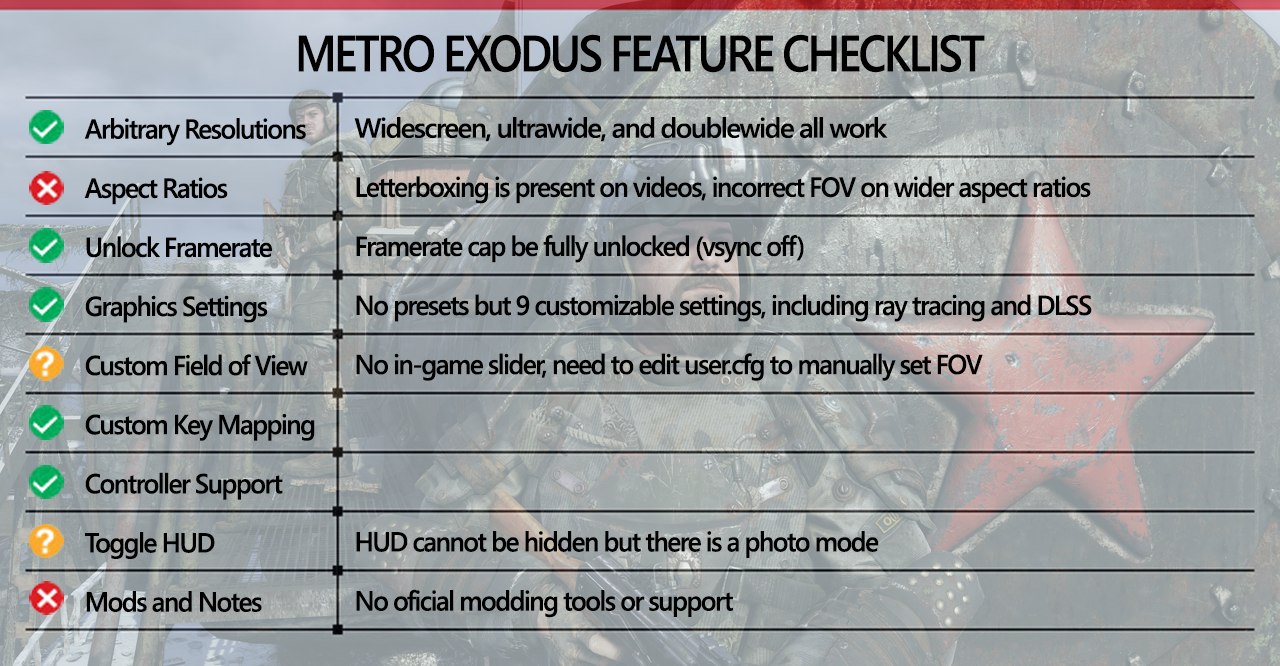
Metro Exodus provides nearly everything we'd expect from a modern PC release, sort of. Getting at some items will require manual intervention—hence the yellow marks. You can select ultrawide (21:9) and even doublewide (32:9) resolutions, but the field of view doesn't automatically adjust. The default behavior can give you a severely stretched view for wider aspect ratios, but there's some help available.
Go into your 'Documents\Saved Games\Metro Exodus' folder and under the saves, you should be able to find a user.cfg file. Edit that and you can input any custom resolution, as well as tweak the r_base_fov setting. The default is 60, but since there's no multiplayer support, hacking the config file and using a wider FOV isn't cheating and appears fully supported. (I tried 3840x1080 and it worked, though you'll get black bars on loading screens and some text in the UI can get cut off.)
Mod support is a red mark as usual. With no official support for modding in the first two games, plus a reportedly difficult engine to work with, I don't anticipate Exodus to do any better. There's no toggle HUD feature either, but there is a photo mode. It's possible there's a setting in the config file that will disable the HUD as well, though I didn't find one in my initial look.
Basically, you get resolution support, a framerate that can be fully unlocked, controller support, and the ability to customize the key mapping. At least most of the limitations can be worked around.
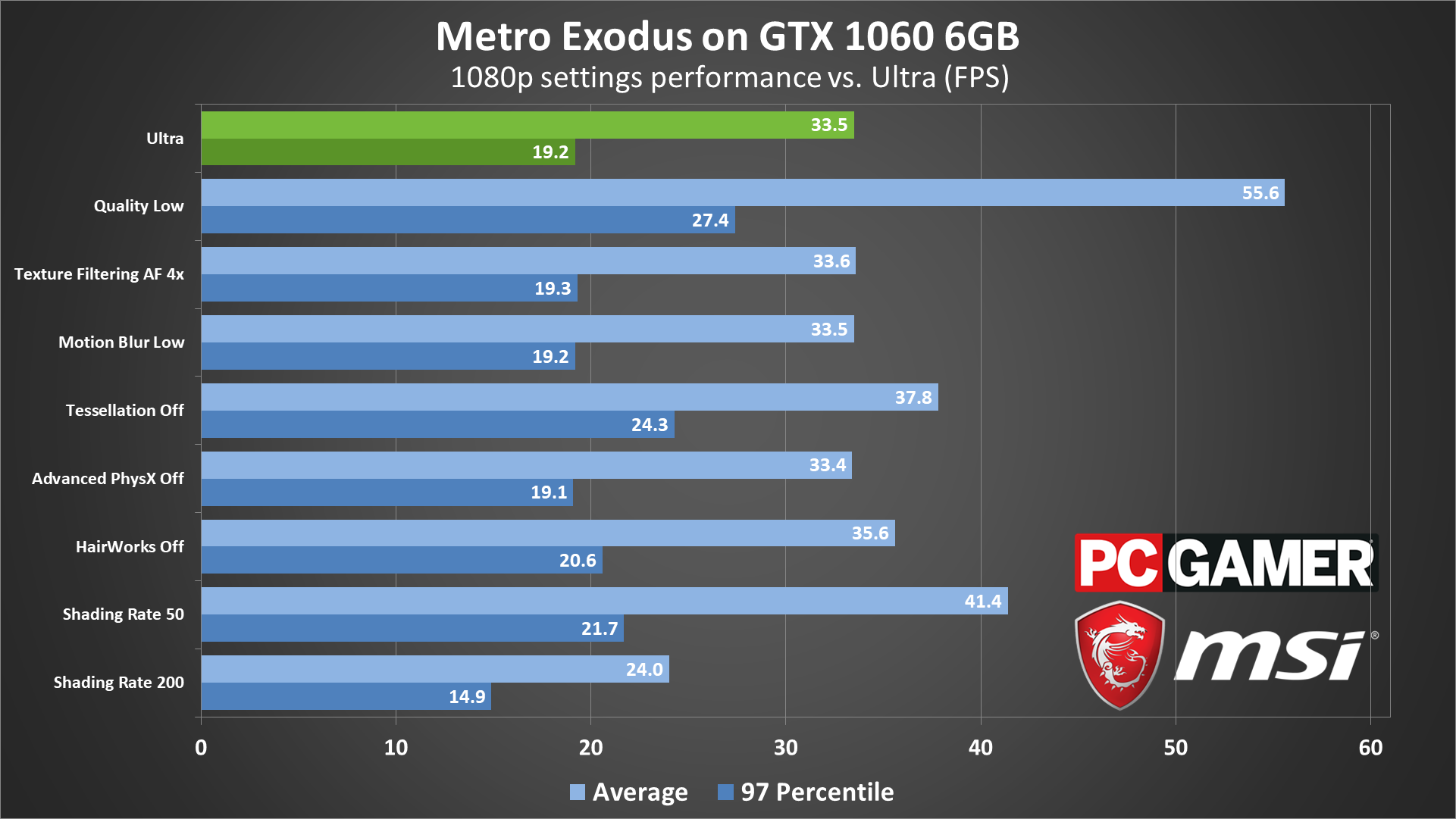
Swipe left/right for additional images
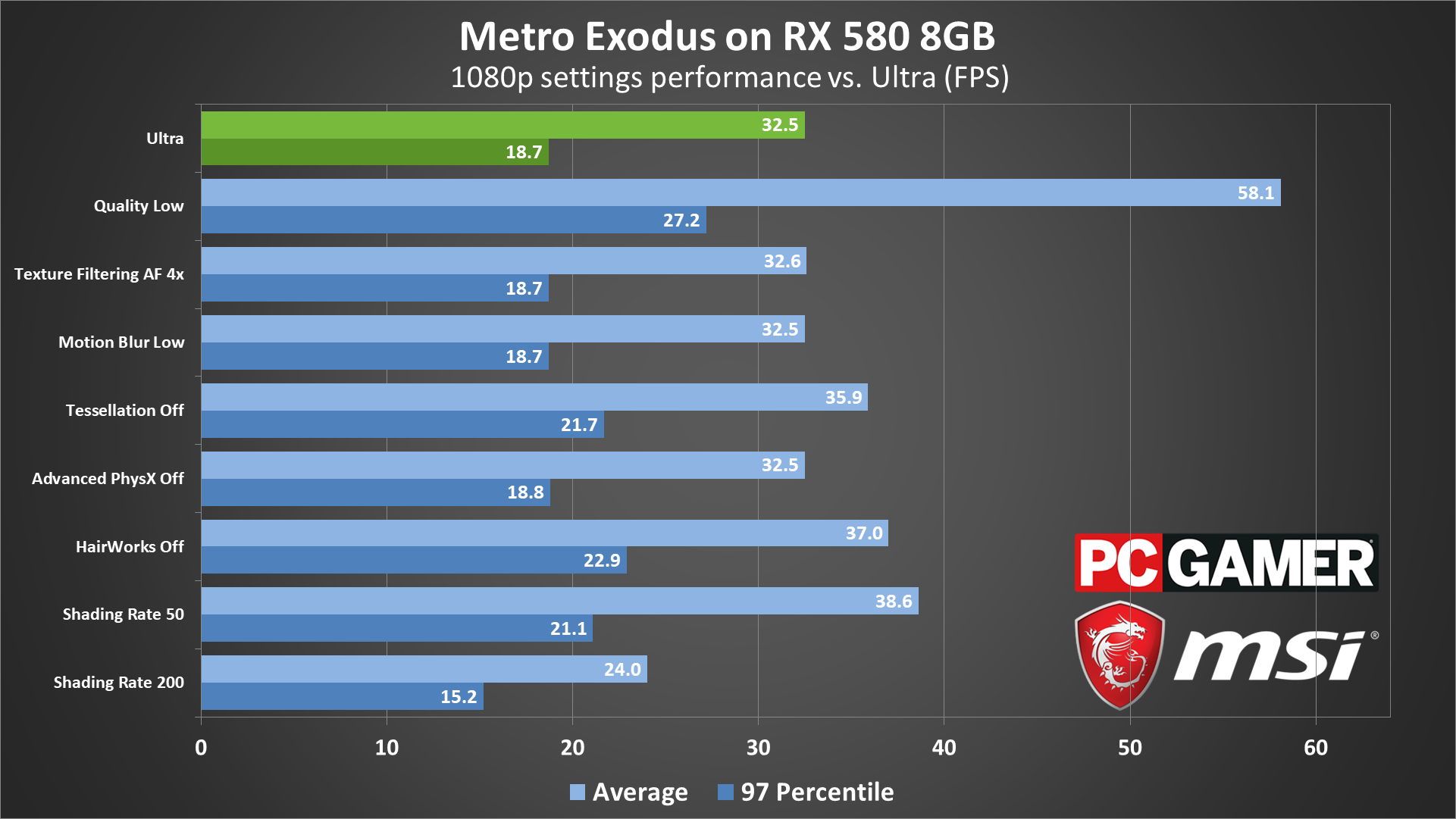
Swipe left/right for additional images
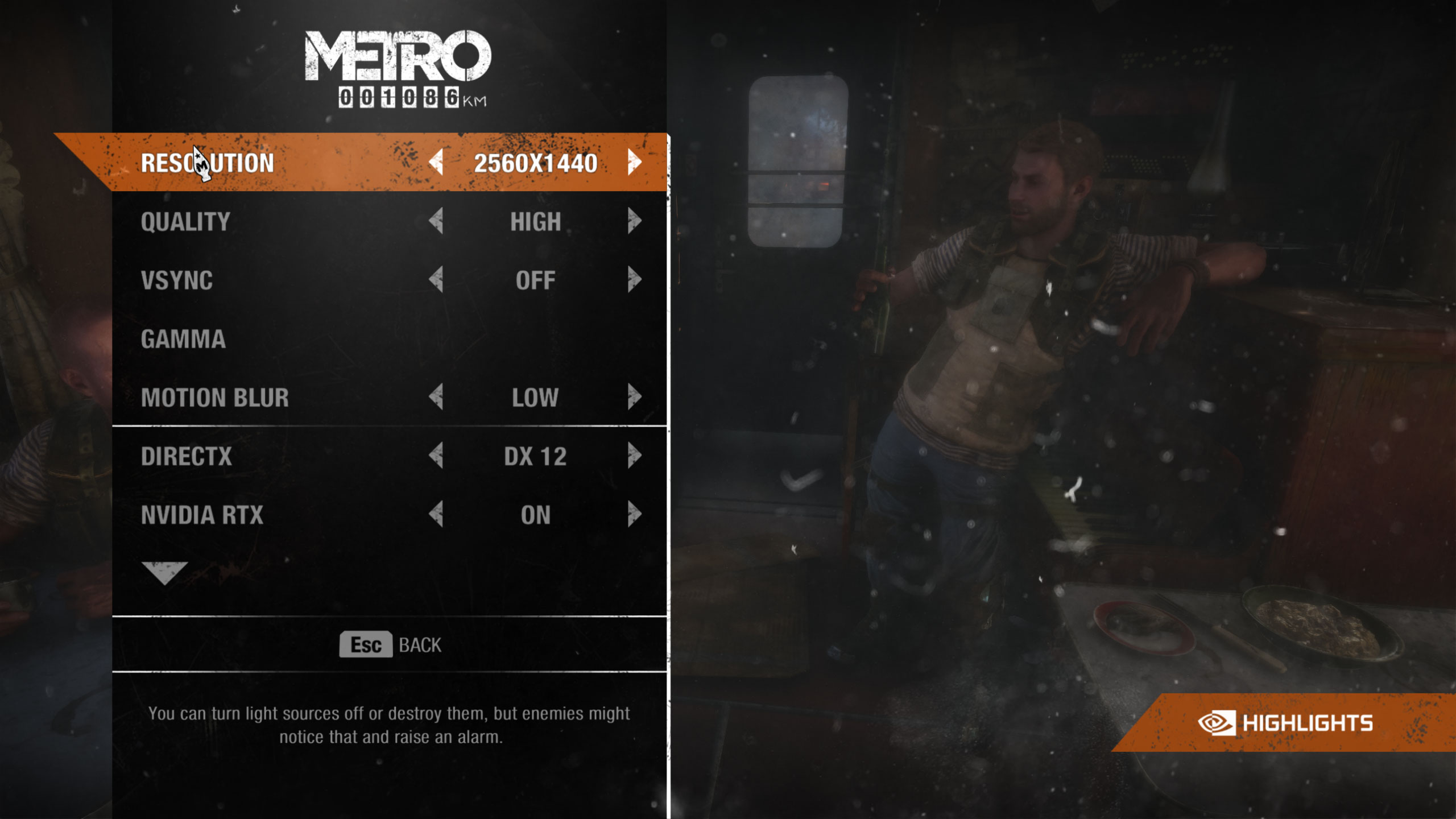
Swipe left/right for additional images
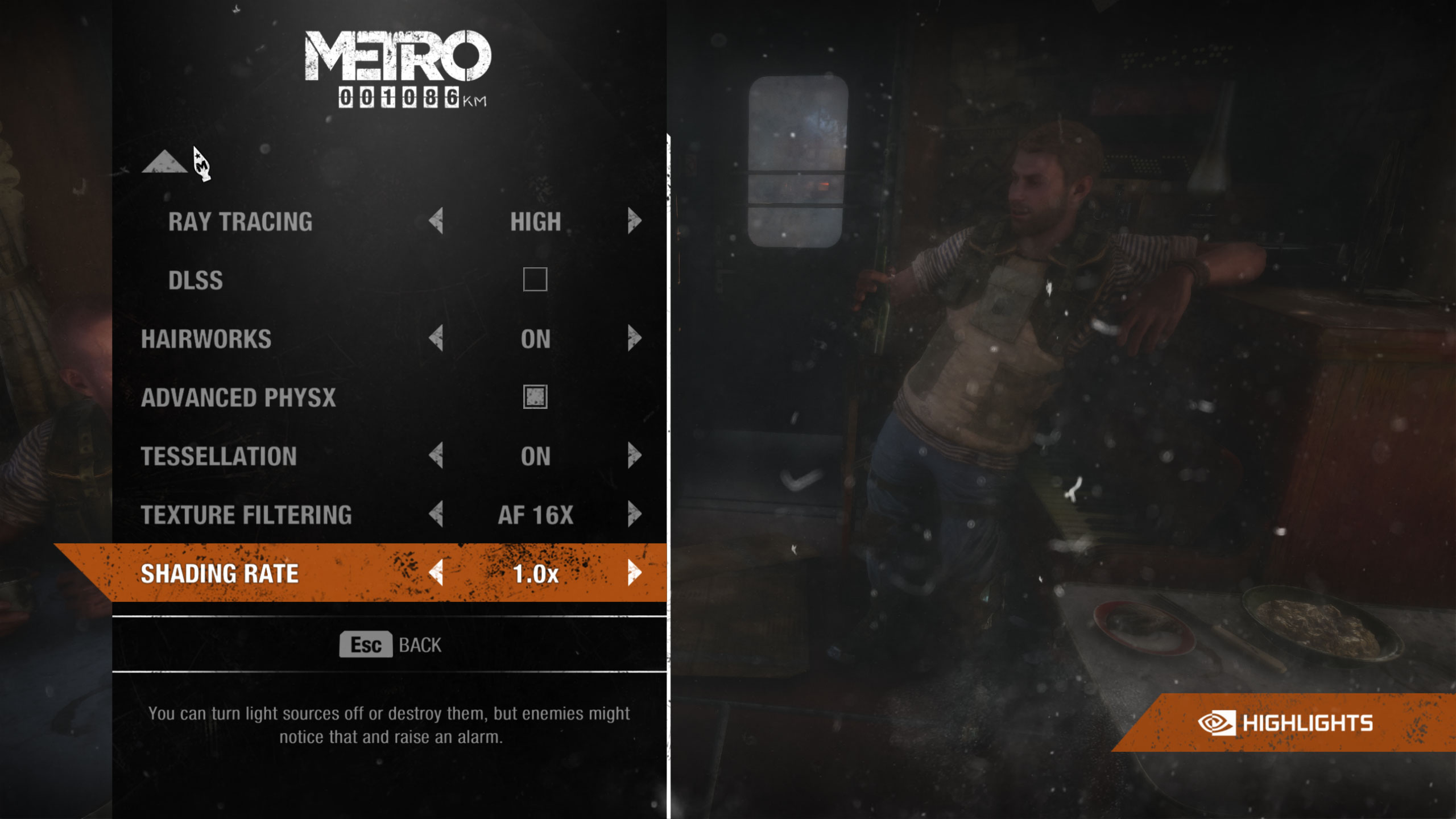
Swipe left/right for additional images
Metro Exodus settings overview
As our partner for these detailed performance analyses, MSI provided the hardware we needed to test Metro Exodus on a bunch of different AMD and Nvidia GPUs, multiple CPUs, and several laptops—see below for the full details, along with our Performance Analysis 101 article. Thanks, MSI!
The graphics settings Metro Exodus exposes are a bit odd. I gave Metro Exodus a green in our features list, mostly because it's only the second game to have public ray tracing and DLSS support—the first to have both—and it actually made it into the shipping release. (I was skeptical that would happen, after waiting for over five months now for the Shadow of the Tomb Raider patch.) That's the good news, but if you don't have an RTX card, there are only a few settings you can tweak.
The biggest gaming news, reviews and hardware deals
Keep up to date with the most important stories and the best deals, as picked by the PC Gamer team.
As with the previous Metro games, things like ambient occlusion, texture quality, etc. are all missing. There are nine graphics settings to tweak, but two of those are only for RTX cards, and two more don't affect performance or image quality much. Let's quickly run through the settings and briefly list what each does, as Metro Exodus doesn't provide any explanation.
Quality: This is a single setting that appears to cover all of the normal 'advanced' options you see in other games. This affects post-processing, anti-aliasing, texture and shadow resolution, lighting, shadows, and more. As expected, it has a massive impact on overall performance as well as image quality. Going from ultra to low will boost framerates by up to 70-80 percent (depending on your GPU and other settings), while going from ultra to extreme will drop performance about 20 percent. Note that enabling RTX effects is only possible if Quality is set to medium or above.
Motion Blur: Sets the quality of motion blur to low, medium, or high. This has very little effect on performance. (You can disable motion blur completely in the config file if you prefer.)
Above is one of the better scenes showing the difference between ray tracing and traditional rendering from Metro Exodus. Note however that even the ray traced version has many oddities, like why doesn't the gun or guitar or cup cast a shadow, other than on itself? That's because GI isn't necessarily concerned with casting shadows, but rather the default brightness from a single global light source. Right click and open the two images in a new tab if you want to compare the full resolution images.
Ray Tracing: For Nvidia RTX cards, enables or disables ray tracing—in this case, ray tracing is only used for global illumination (GI). In that sense, it's almost the reverse of Battlefield 5, which used ray tracing exclusively for reflections. GI helps to light up the scenes, and without GI you often get areas that are either too bright. Anyway, it can have a clear impact on visuals in some areas of the game (especially in buildings and such), but many algorithms exist that already do a decent job at approximating GI. Either way, ray tracing can be set to off, high, or ultra on an RTX card. The high setting drops framerates about 30 percent while the ultra setting drops framerates about 40 percent (depending on your GPU, resolution, and other settings).
DLSS: Also for Nvidia RTX cards, this enables or disables the use of DLSS. It's not clear what resolution is used prior to DLSS being applied, but the visual difference at 1080p didn't feel as great as at 4k. Enabling this can boost performance about 20-40 percent if you're using ray tracing, but you can also use DLSS without ray tracing and get a 15-30 percent boost to framerates—both come at the cost of image fidelity and blurriness, however. DLSS can only be enabled at 1440p and above for the RTX 2080/2080 Ti, or 1080p and above for the RTX 2060/2070.
Another comparison, this time with and without DLSS. Right-click and open each image in a new tab to see the full resolution images, where the fuzziness is far more apparent. If you're wondering what the above scene looks like without ray tracing, we have that as well.
HairWorks: Enables higher quality fur and hair on certain creatures. HairWorks is part of Nvidia's GameWorks library, but it will run on AMD GPUs as well. Turning this off improves performance by 6 percent on Nvidia GPUs and 14 percent on AMD GPUs—at least in the benchmark scene (which has a hairy bunny at the start).
Advanced PhysX: Another formerly Nvidia exclusive technology, we don't hear much about PhysX these days—probably because other physics libraries are more popular. This will work on both AMD and Nvidia GPUs, though turning it off did not affect framerates (in the benchmark at least).
Tessellation: Add depth (more polygons) to otherwise flat geometry. Turning this setting off increases performance by 10-13 percent.
One more comparison: HairWorks on vs. HairWorks off. It's only used for fur as far as I can tell, or at least that's one readily visible difference. Look at the cute little bunny!
Texture Filtering: There are only two options, 4x anisotropic filtering and 16x AF. It's difficult to see the visual improvement going beyond 4x in most games, Exodus included, and turning this down to 4x has no significant effect on performance.
Shading Rate: This setting determines how many shaders are run per pixel, with 100 being the normal 1:1 ratio. It has a range of 0.4x-4.0x, with 0.5x being somewhat like 50 percent resolution scaling except only applied to pixels (not geometry or other elements), while 2.0 is sort of like 2x supersampling for shader calculations. This can have a significant impact on performance as well as visual quality. Setting this to 0.5x improves performance by 18-24 percent, while increasing this to 2.0x decreases performance 25-30 percent—I didn't even try maxing it out at 4.0x. Most people should leave this setting at 1.0, though the low preset in the benchmark utility sets it to 0.5.
MSI provided all the graphics hardware for this testing, including the latest GeForce RTX cards. All of the GPUs come with modest factory overclocks, which in most cases improve performance by around 5 percent over the reference models.
My primary testbed uses the MSI Z390 MEG Godlike motherboard with an overclocked Core i7-8700K processor and 16GB of DDR4-3200 CL14 memory from G.Skill. I've also run additional tests on other Intel CPUs, including a stock Core i9-9900K, Core i5-8400, and Core i3-8100. AMD's Ryzen 7 2700X and Ryzen 5 2600X processors (also at stock) use the MSI X470 Gaming M7 AC, while the Ryzen 5 2400G is tested in an MSI B350I Pro AC (because the M7 lacks a video outputs). All AMD CPUs also used DDR4-3200 CL14 RAM. The game is run from a Samsung 860 Evo 4TB SATA SSD on desktops, and from the NVMe OS drive on the laptops.
I’ve used the latest Nvidia 419.17 and AMD 19.2.2 drivers for testing, and updated the results. Earlier testing doesn't show markedly different performance. Future driver updates and patches could change things, of course, but there's not much I can do about that.
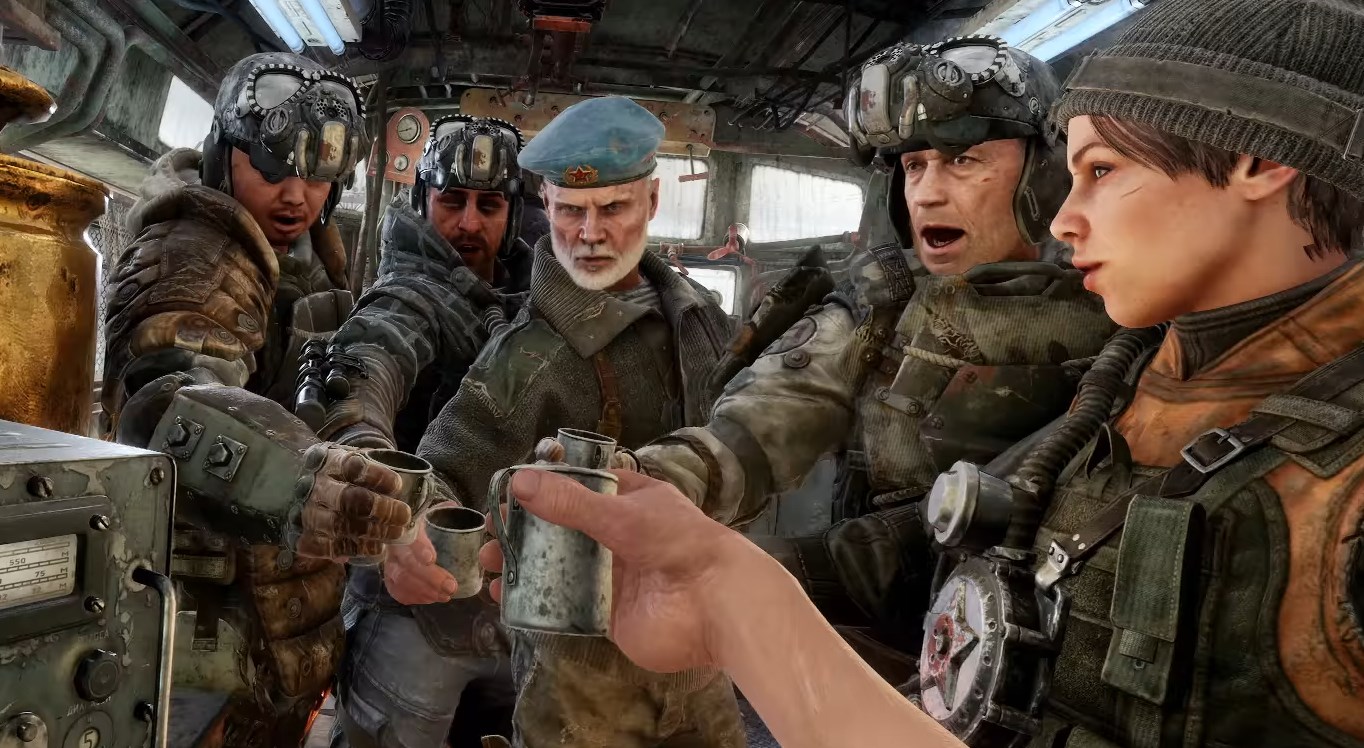
Metro Exodus: how we tested
There are quite a few wrinkles to iron out before we get to the benchmarks. First things first, while Metro Exodus supports ray tracing and DLSS, the benchmark utility that I'm using for these results currently has a bug that causes DLSS to not work. It works in the game, but not in the benchmark. So why not just skip the benchmark and do everything manually? I could, but after doing some testing, I found that the benchmark tends to be more demanding than most areas of the game that I've encountered (though admittedly I'm not that far along in the game—just to the first train stop area).
I like using publicly available benchmarks when possible, as it allows others to compare results, so I'm sticking with the benchmark utility (found in the game's installation folder). However, I did do some in-game testing of DLSS for reference. I won't include those figures in the charts, since they're from a different test sequence, but enabling DLSS improved performance by up to 40 percent. It also appears to cause excessive blurriness at higher resolutions, so if you were hoping DLSS would work something like the following, be prepared for some disappointment.
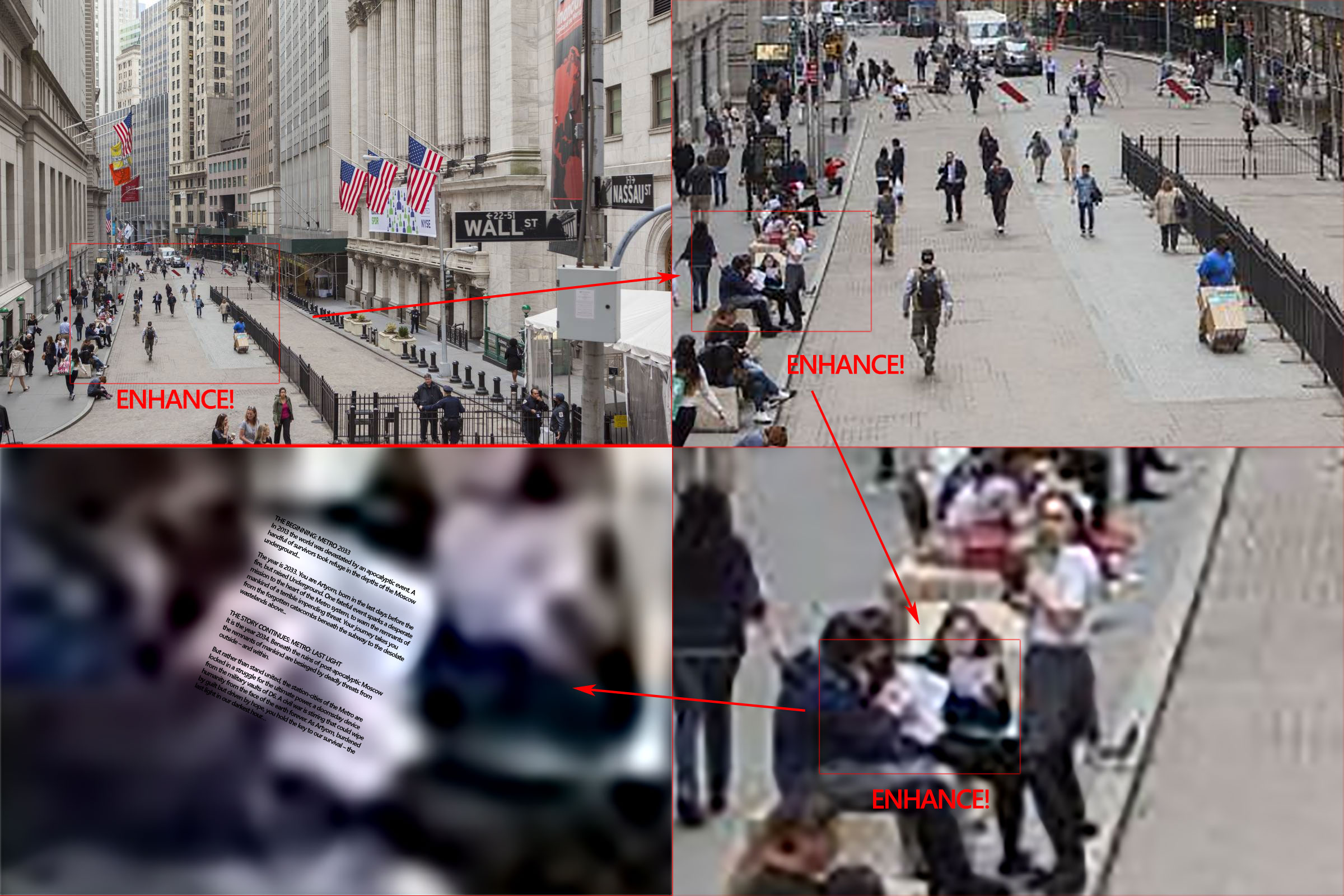
Nvidia does give a disclaimer about DLSS quality as well, but it feels a little disingenuous. "Our supercomputer never sleeps. It is constantly doing more training to improve performance and image quality. When we reach a big milestone, we send out an update so gamers can get the latest and greatest. It's possible that a new set of performance and image improvements will become available after review and around the time the game launches."
Sure, it's possible, but after seeing the current state of DLSS image quality, I'm left feeling more than a little skeptical. Fundamentally, there's only so much that can be done to fill in 'missing' information. Deep learning algorithms have proven incredibly robust at performing certain kinds of work, and I don't doubt that DLSS can improve image quality at the same resolution compared to no DLSS. But having seen the results in Final Fantasy 15 and now Metro Exodus, it feels much more like DLSS is there to make ray tracing viable by reducing the target resolution, not because it can meet or exceed the quality of other forms of anti-aliasing.
Also note that a DLSS update has apparently come out since my initial testing. Things may have improved somewhat, but having looked at both Battlefield 5 and Metro Exodus, with and without DLSS, I remain of the opinion that the non-DLSS looks better. Then again, I also think TAA often adds too much blur. YMMV.
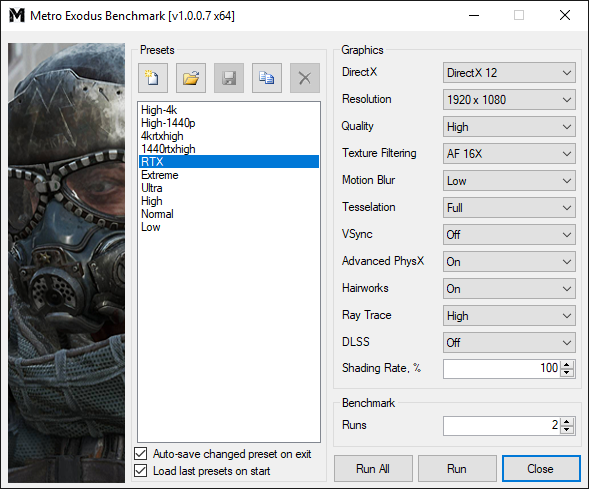
Metro Exodus doesn't include any presets as such, but the benchmark tool does have low, normal, high, ultra, and extreme presets defined, along with RTX (which is ultra plus high ray tracing with DLSS enabled). I've tested at 1080p using the five presets, plus 1440p and 4k using the high preset. I've also tested with ray tracing enabled at all three resolutions, only using the 'high' settings rather than ultra, and without DLSS.
Why not go for ultra or extreme? The latter is easy to write off, since it bumps the shading rate to 2.0x—a form of supersampling that's too demanding for any current GPU to really handle. Looking at the high, ultra, and extreme options, there's also a relatively minor difference in image quality, so I've opted for the high setting at higher resolutions so that they're potentially within reach of some of the GPUs. But if you're wondering, even the RTX 2080 Ti only gets 49 fps at 4k ultra, and that drops to 31 fps with ray tracing at ultra as well, so no one is likely to actually play at that setting using current hardware.
Two final items to point out. First, Metro supports both the DX12 (it's required if you want to use ray tracing and/or DLSS) and DX11 APIs. For these tests, I'm only looking at DX12 performance, though I did check DX11 mode as well. I can't speak to every possible GPU, but at least on the GPUs I checked, there wasn't any benefit to running in DX11 mode—that may not be true of older generation graphics hardware, however. The second point is that Metro Exodus is an Nvidia promoted game—you can get a free code with the purchase of an RTX graphics card from certain retailers. As usual, that means there are potentially better optimizations for Nvidia than AMD, but there's not much to do about it other than run the benchmarks.
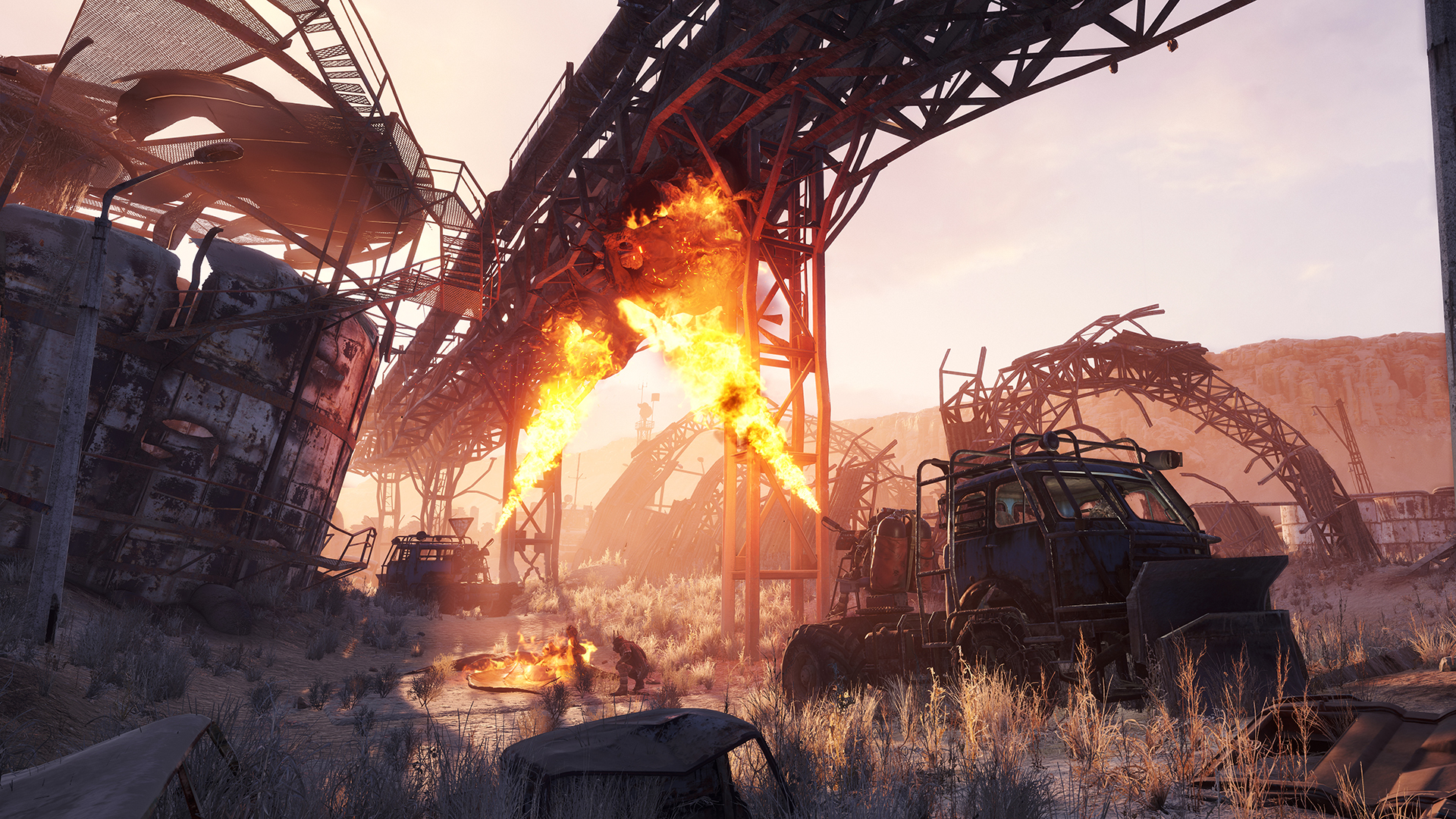
Metro Exodus graphics card benchmarks
Starting with the graphics card benchmarks, all testing was conducted using an overclocked i7-8700K processor, in order to reduce any other potential bottlenecks. (CPU benchmarks are down below, or will be soon enough.) Even though I wouldn't normally include testing of every 'preset,' the benchmark utility makes it relatively painless so I have seven different charts. The results of my testing also back up the Metro Exodus system requirements, which are quite beefy. Plenty of GPUs can do 30fps or more, especially at 1080p low, but for 60fps at 1080p medium and above, you'll need a reasonably high-end graphics card.
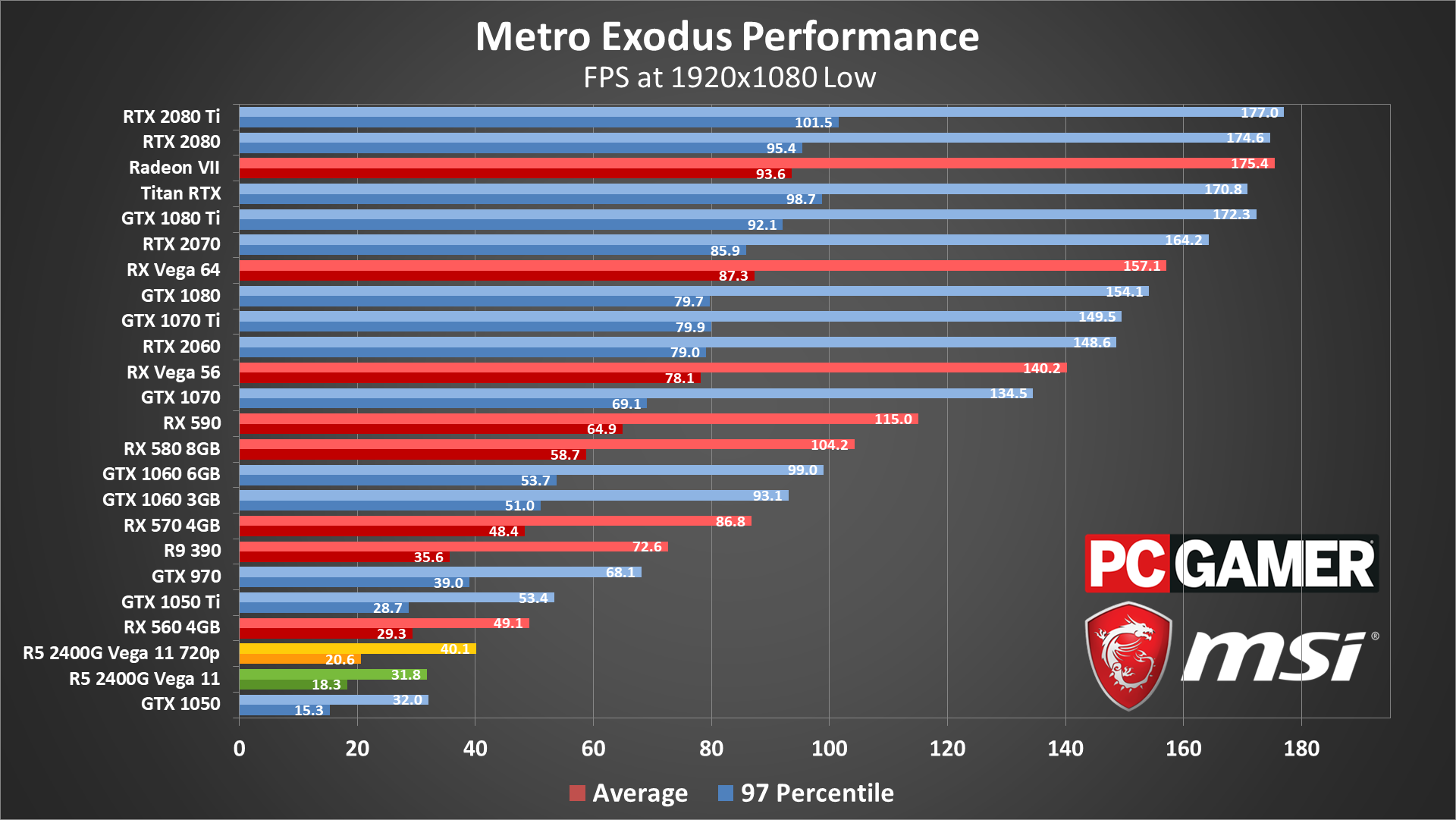
As I mentioned at the beginning, Metro games have a well-earned reputation for being quite demanding. Metro Exodus doesn't break with tradition, meaning even relatively potent GPUs can struggle, and budget GPUs aren't going to maintain 60fps at 1080p, not even close. The low preset even drops the shading rate to 50 percent, meaning half as many pixels and some clear loss of visual fidelity.
If you're hoping for 60fps average at minimum quality, you'll need at least an RX 570, and if you want to keep minimum fps above 60, you'll need a GTX 1070 or better. Low-end integrated graphics solutions basically won't do well in Exodus, assuming they can run it at all. AMD's Vega 11 somehow manages to just squeak past the dedicated GTX 1050 GPU (probably because of the lack of VRAM on the 1050), plugging along with a 40fps average, but minimums are in the 20s. Budget cards like the RX 560 and GTX 1050 Ti come in just shy of 50fps, though you can certainly play the game at 20-30 fps in a pinch.
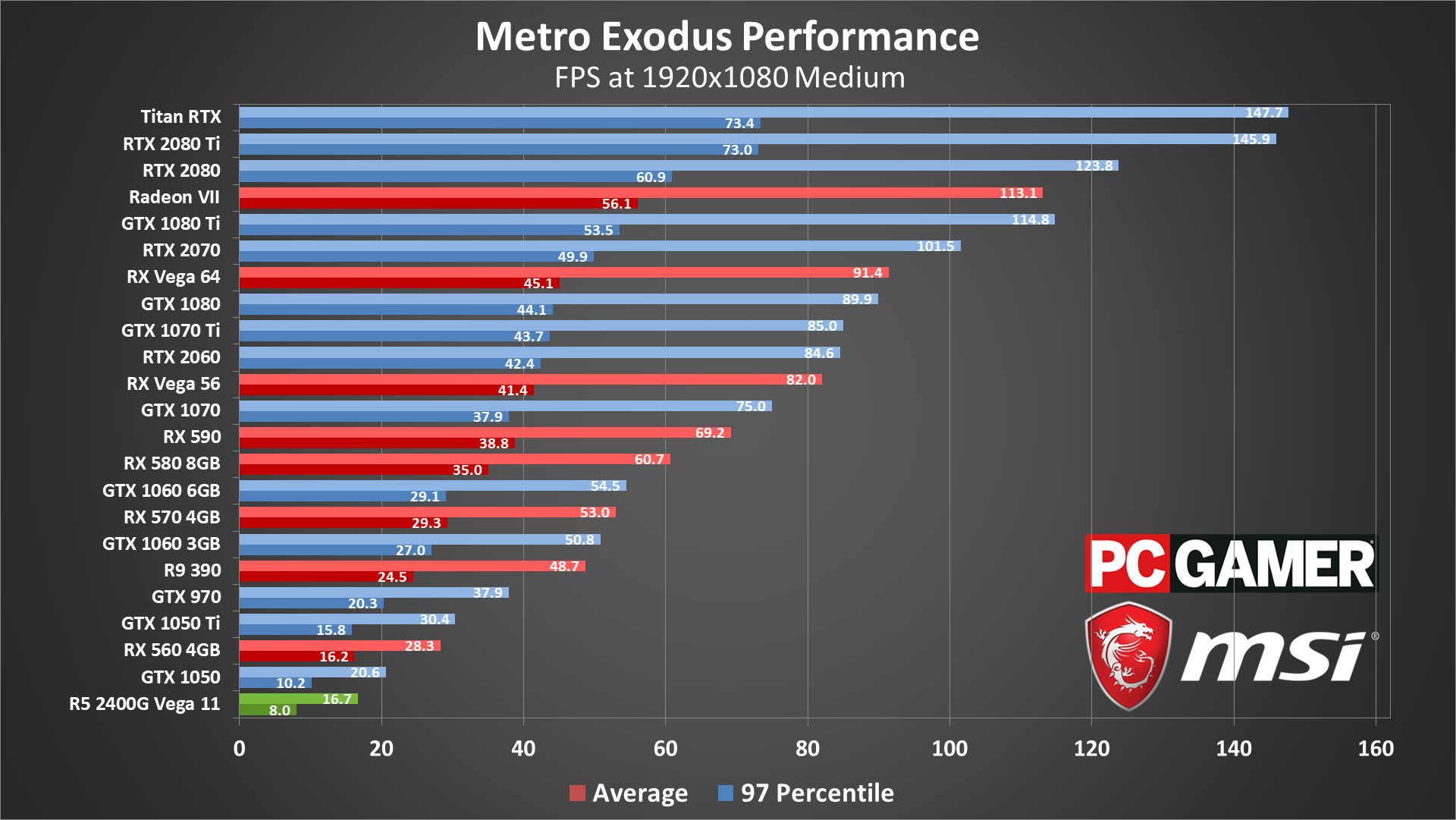
The normal setting puts shading rate at 100, which along with the increase in the quality setting immediately results in a large boost in image quality and a large hit to performance—midrange and budget GPUs lose nearly half of their performance. I'd be interested in seeing Metro Exodus implement variable rate shading—a technique where fewer shaders are used on 'simple' surfaces but more on 'complex' areas, which can supposedly boost performance 15-25 percent. That's another feature Nvidia talked about with its Turing architecture, though, so it wouldn't help older GPUs.
Getting average fps above 60 at the normal/medium setting is still possible with the upper midrange graphics cards like a GTX 1070 or RTX 2060, but only the RTX 2080 Ti (and almost the RTX 2080) keep minimums at or above 60. At least this isn't a multiplayer twitch shooter where high framerates are really important—kick back and relax a bit, and 30fps or higher is usually fine (especially if you have a G-Sync/FreeSync display).
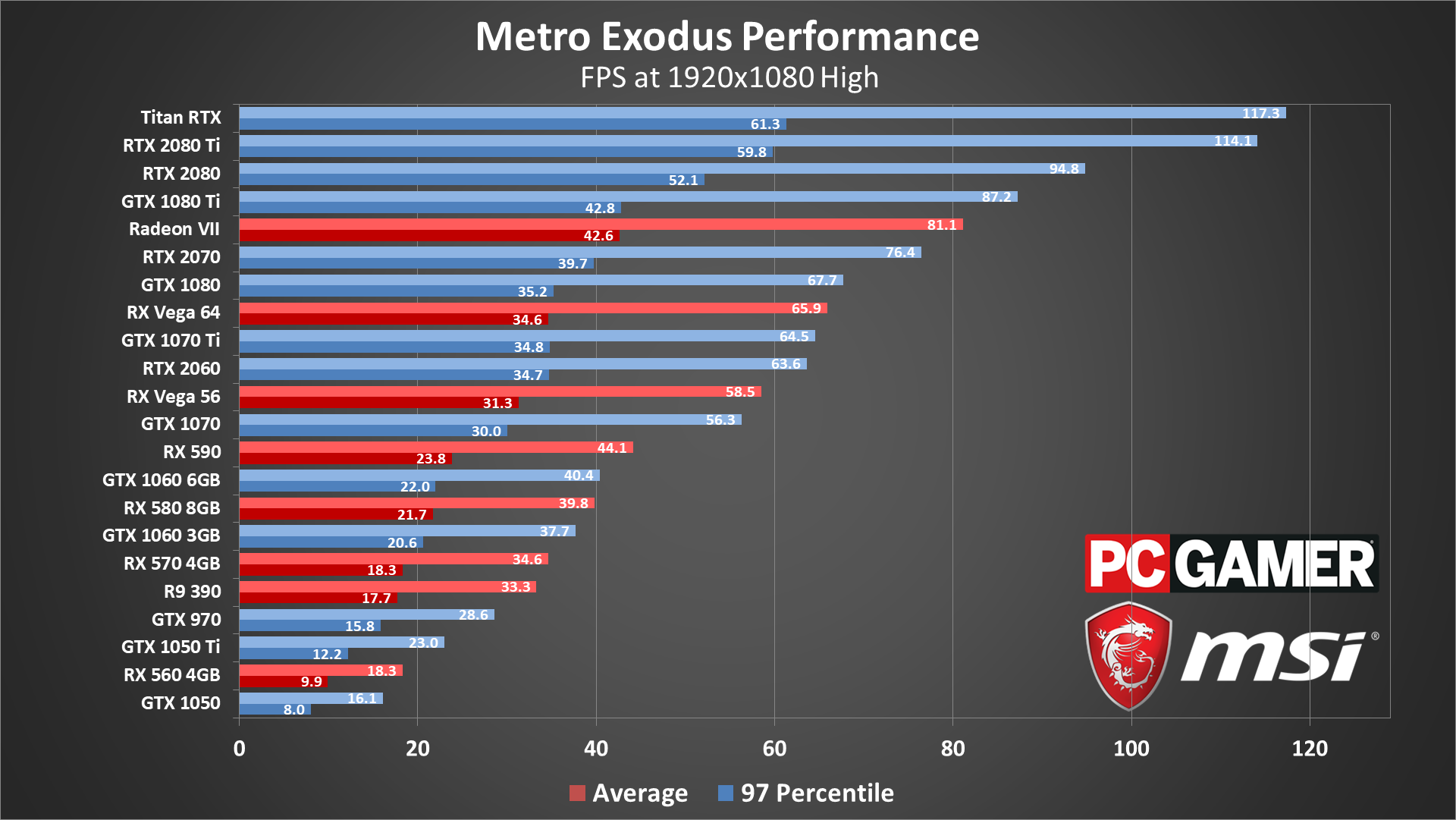
Moving to high quality, still at 1080p, comparatively the performance drop isn't quite as severe as the move from low to medium, but most of the GPUs are already struggling. Mainstream cards like the 1060 6GB and 580 8GB are at 40fps, and it's only going to get worse from here. The RTX 2060 and above may average more than 60fps, but minimums are much lower. The RTX 2080 Ti is the only GPU to break 100fps, and minimums still dip below that mark in some of the more demanding areas of the game.

I've also run tests with ray tracing enabled (set to high, as the visual difference between high and ultra ray tracing is relatively small). Ray tracing causes the RTX cards to lose anywhere from 20-35 percent of their performance. The RTX 2080 takes the greatest hit while the 2080 Ti (and Titan RTX) has the smallest drop. Enabling DLSS (which still tends to look blurrier, though in motion it's not too bad) should offset most of the lost performance, but of course you can only enable DLSS at 1080p with the 2060 and 2070.
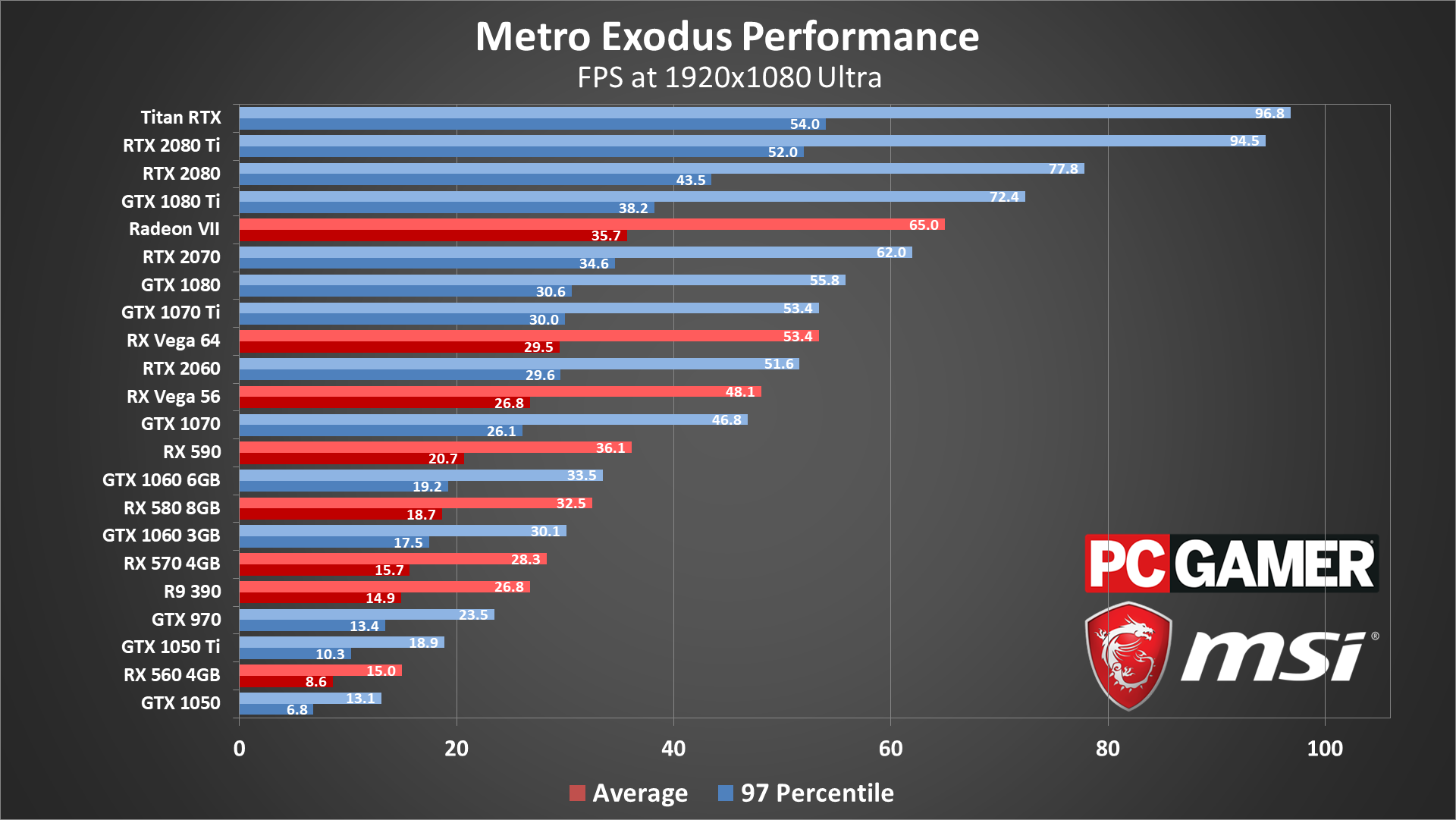
The downward spiral continues with 1080p ultra. Now only the RTX 2070 and above can break 60fps average for Nvidia, and the Radeon VII is the only AMD card to accomplish that feat. The difference in image quality is relatively slight between high and ultra, so unless you have a very fast GPU this is a good stopping point. But I'm not done…
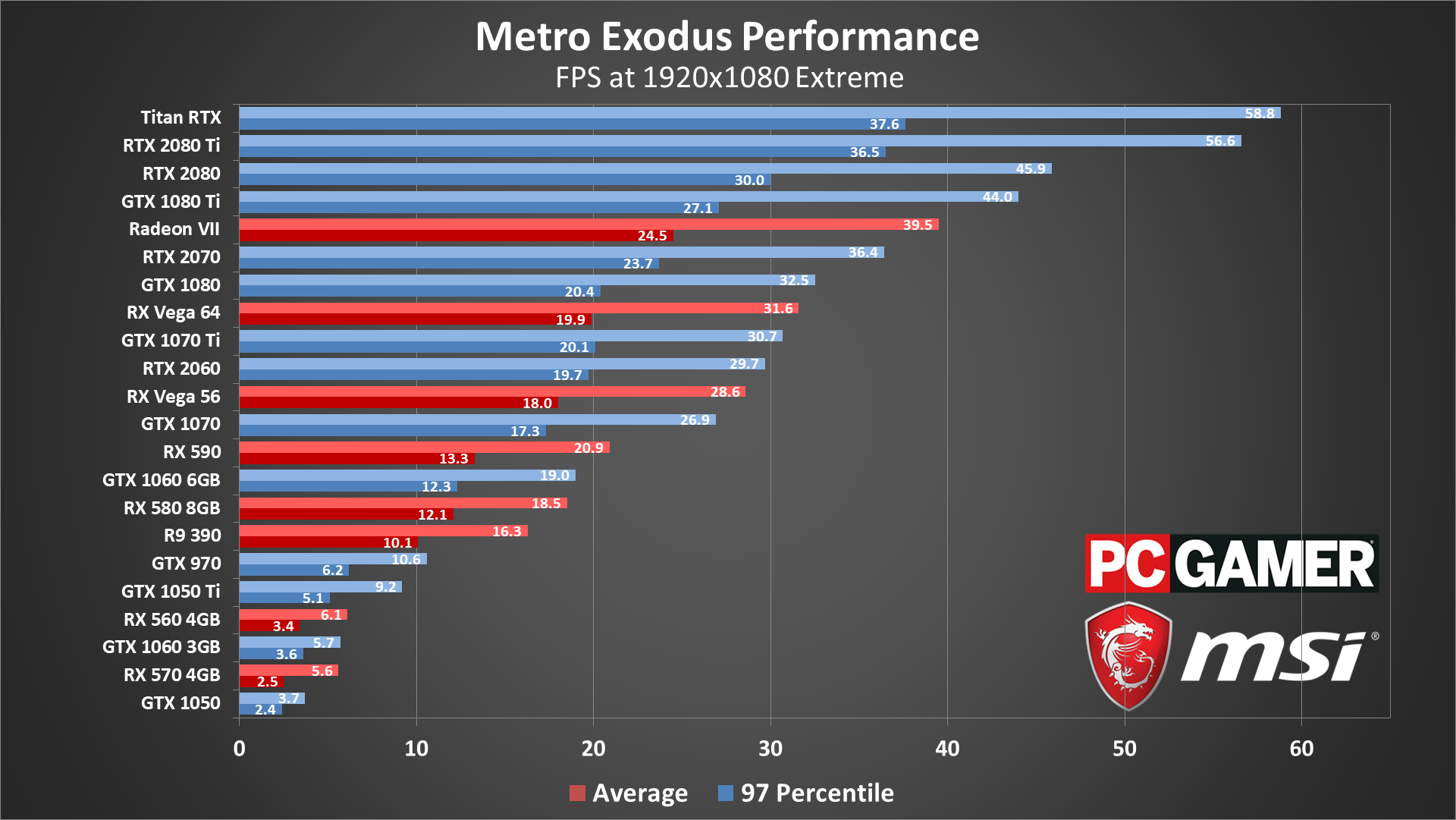
Extreme quality is basically like ultra, only even more demanding. The shading rate is 200, and while there's no specific information on what the Quality setting does, it appears to increase texture resolution, shadow quality, and a few other bits. Anyway, this is one for future GPUs rather than today's hardware. Extreme quality at 1080p is basically as demanding as 1440p ultra or 4k high, and you'll want at least a 6GB GPU to even attempt to run it.
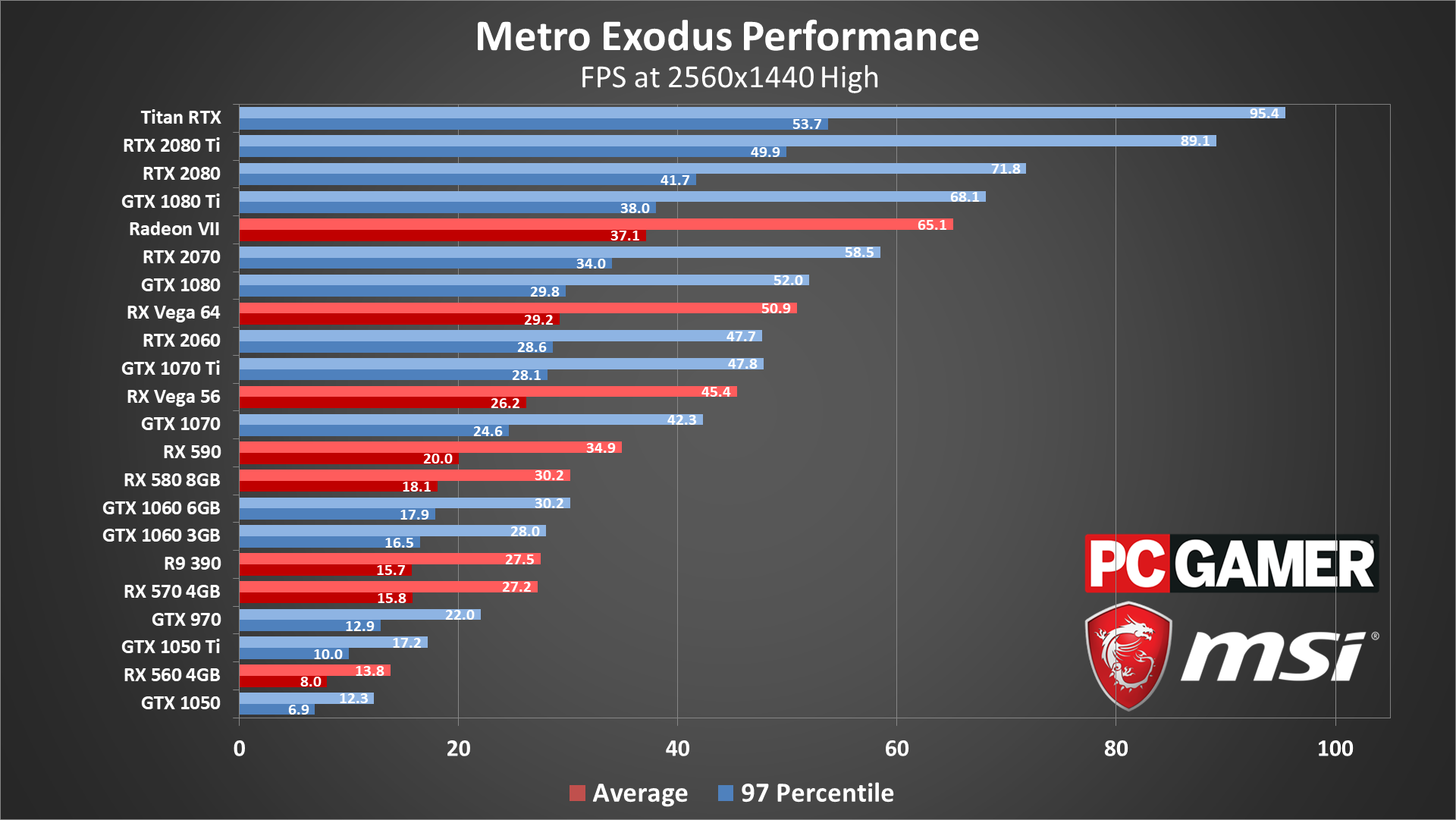
Stepping back to high quality but increasing the resolution, the Radeon VII and up can still average more than 60fps at 1440p high. Other than that, the rankings remains pretty much the same as before.
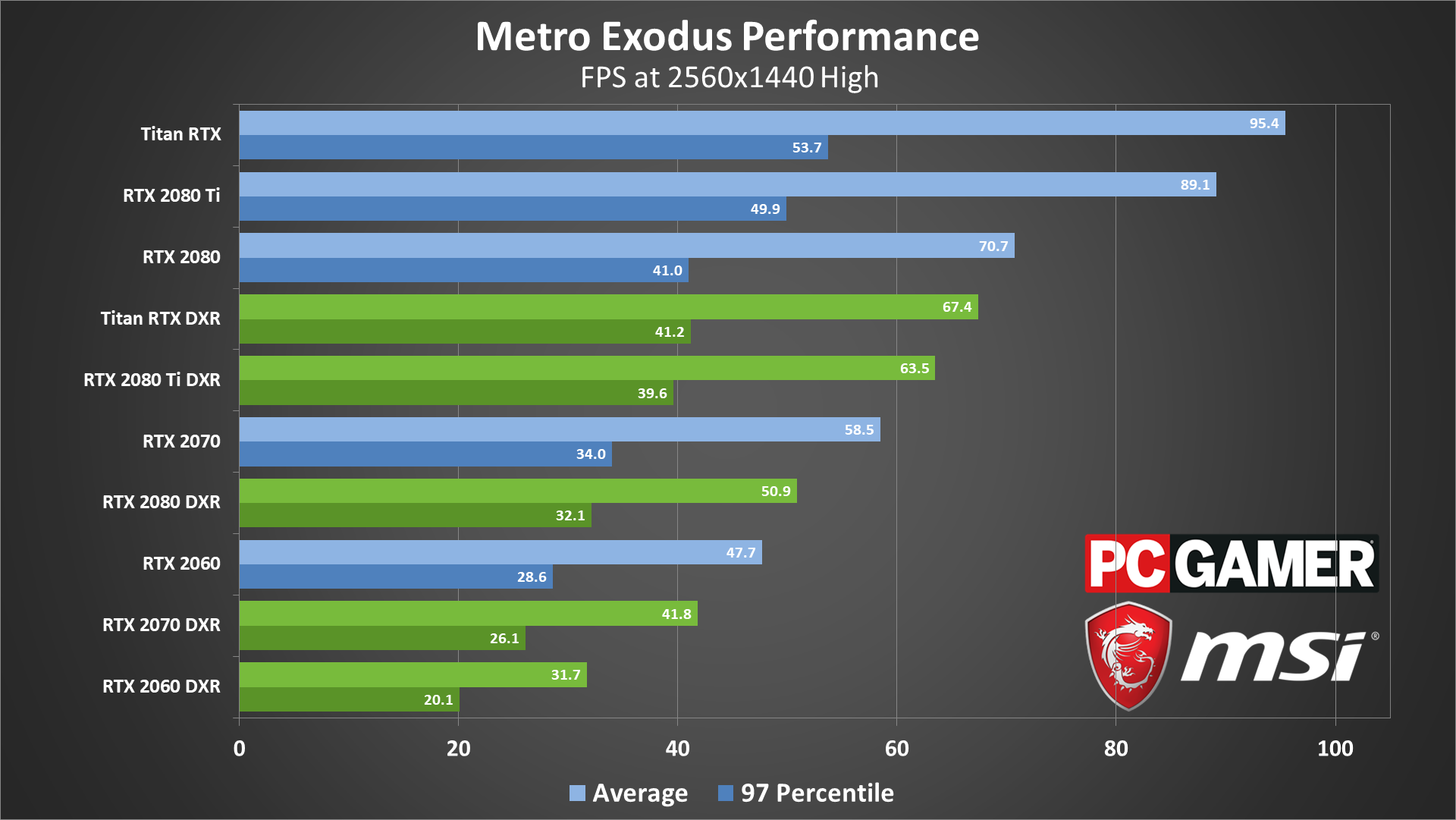
For ray tracing, the 2080 Ti (and Titan RTX) still breaks 60fps as well, even without DLSS, while the other RTX cards fall well below that mark. All of the RTX cards also drop 30 to 35 percent of their performance by enabling ray tracing.
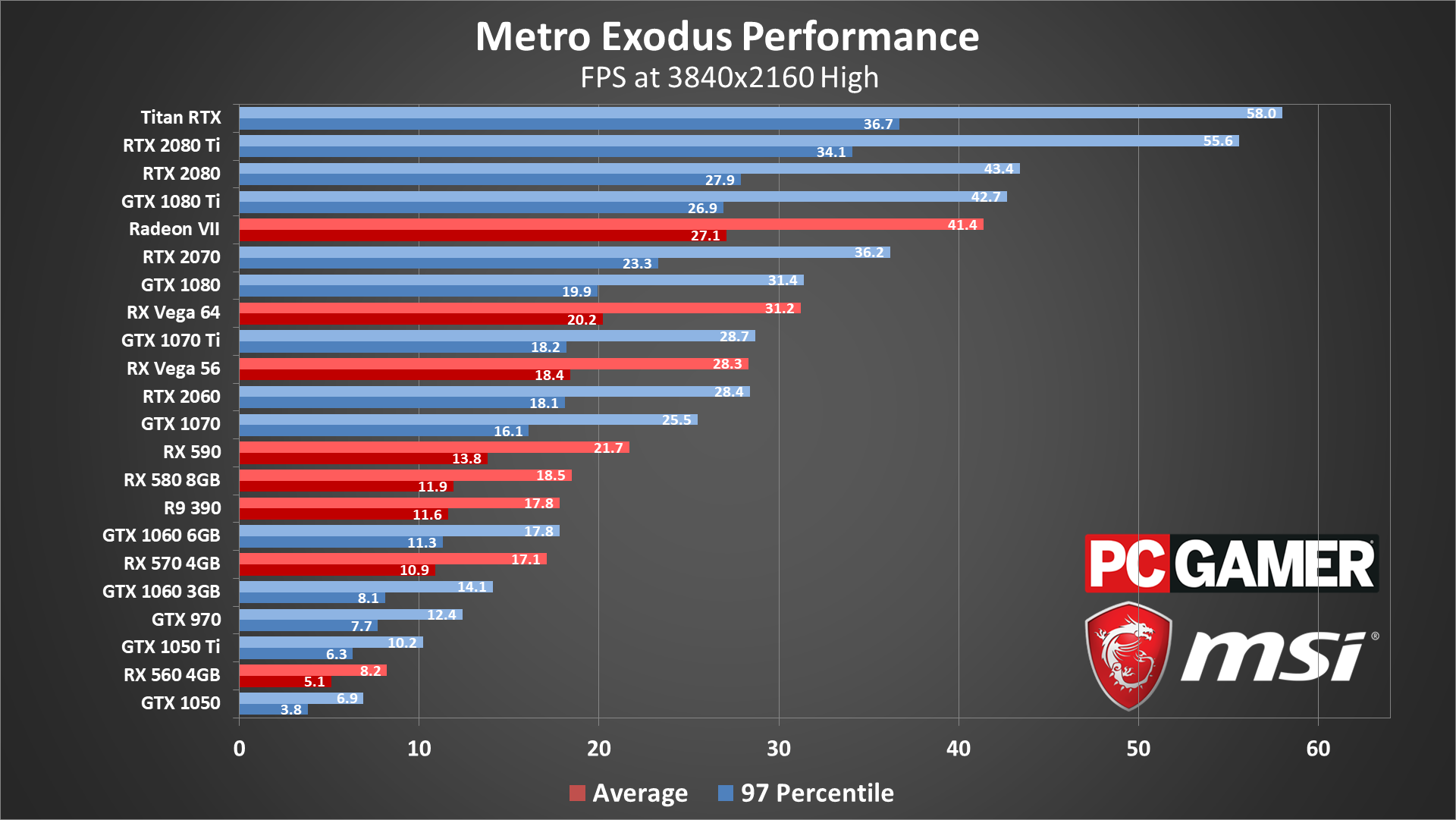
4k 60fps at high quality isn't really within reach of most GPUs right now—even a Titan RTX comes up just shy of that mark, though there are plenty of areas in the game where it would break 60fps as well.
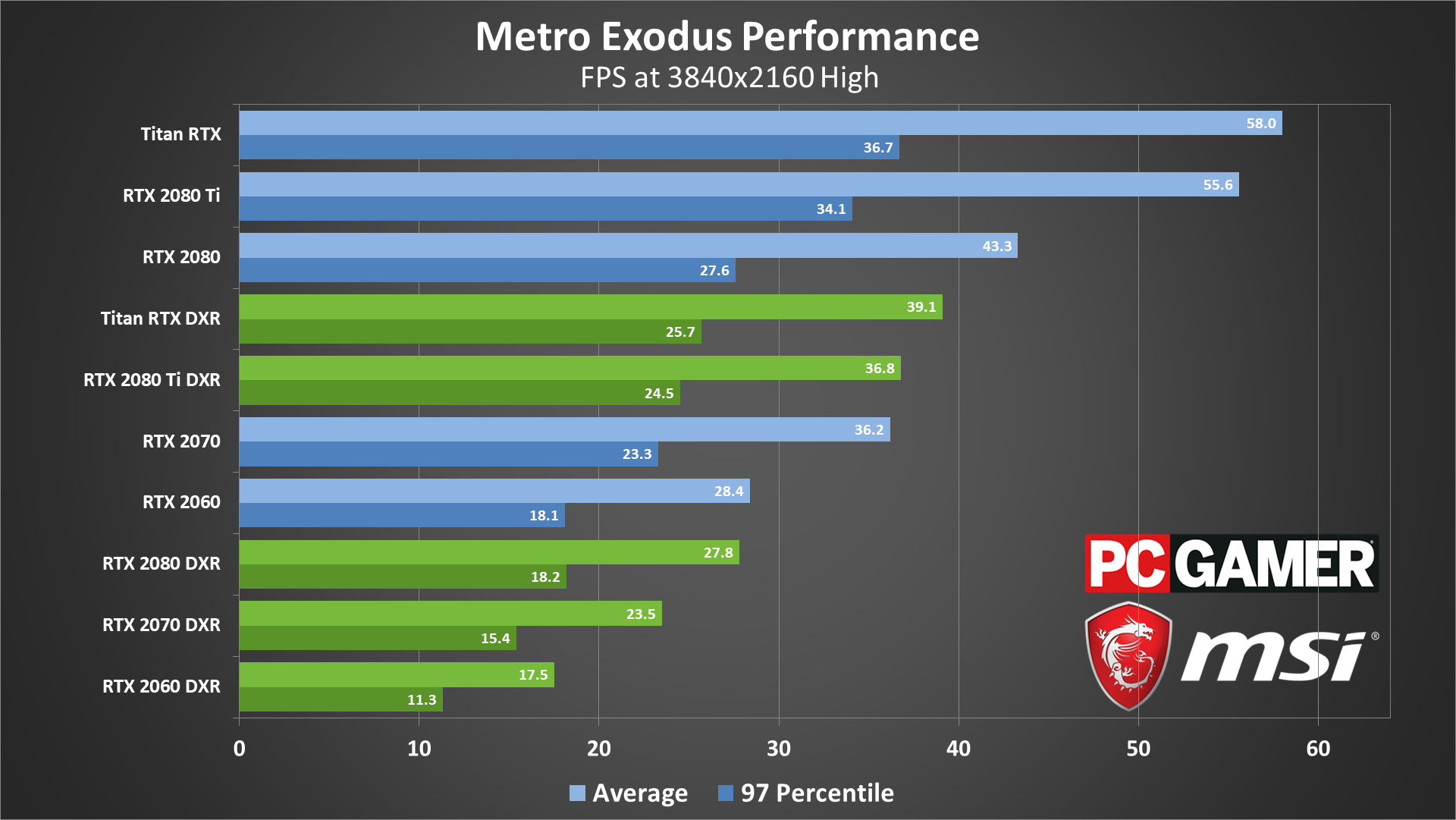
Turn on ray tracing and framerates drop about 35 percent again. And if you want to think about running the game in 10 years, 4k ultra and extreme are there to really push the limit. Again, DLSS can improve performance, but the fuzziness it currently brings in my opinion is worse than just running at a lower resolution and letting your monitor stretch the image to fill your screen. (Yes, I've tried both, and given the better overall experience with 1440p 144Hz with FreeSync or G-Sync, it's a more popular solution regardless.)
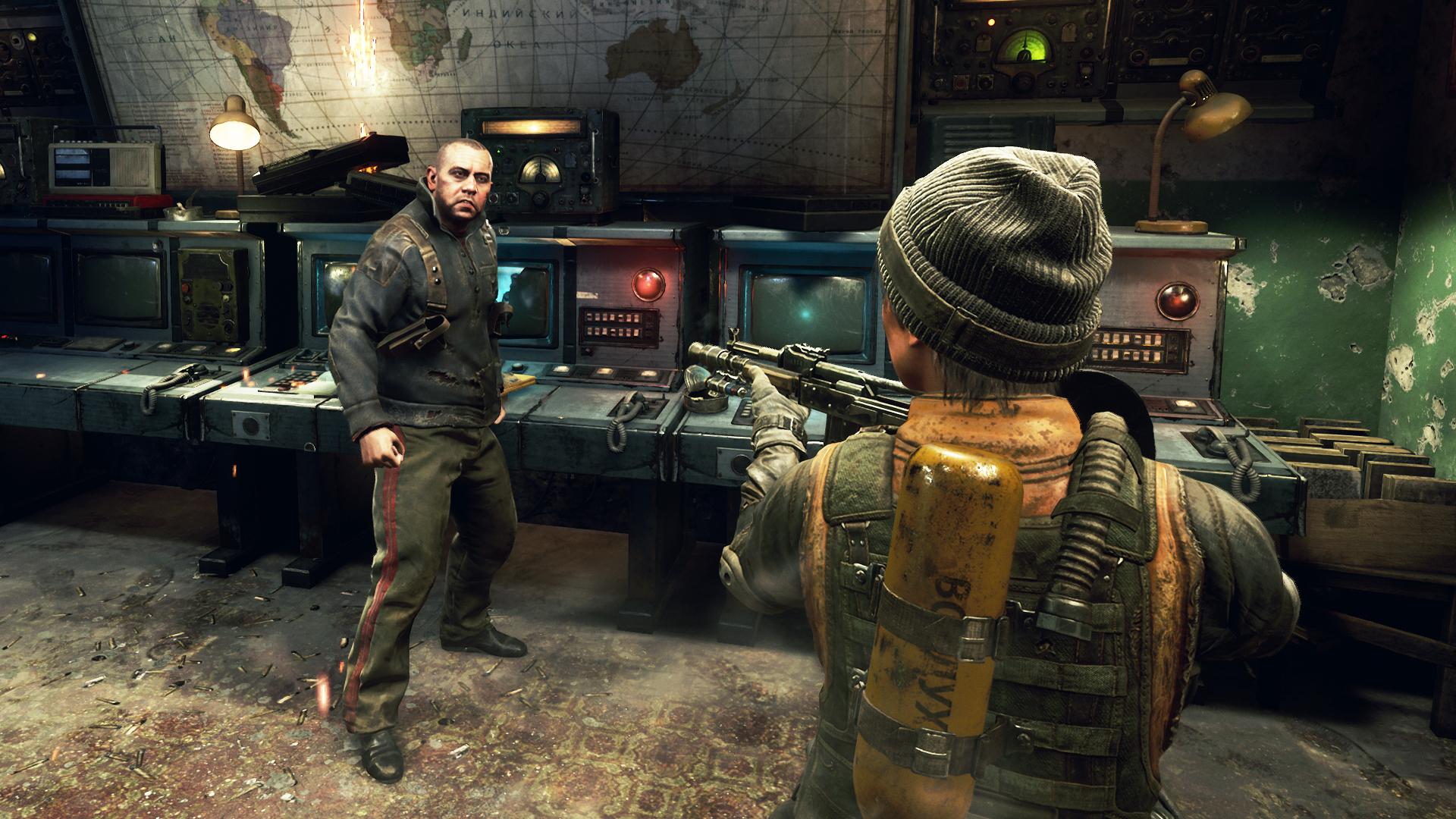
Metro Exodus CPU performance
I have a bunch of CPU results that I'm stuffing into a single gallery, so make sure to click through them. Lower resolutions and settings tend to make the CPU more of a factor, but in my testing the CPU tends to be less of a factor than in other games. Anyway, here are results, with and without RTX enabled (but not DLSS), using an RTX 2080. (Ray tracing was only enabled on the three high settings charts.)
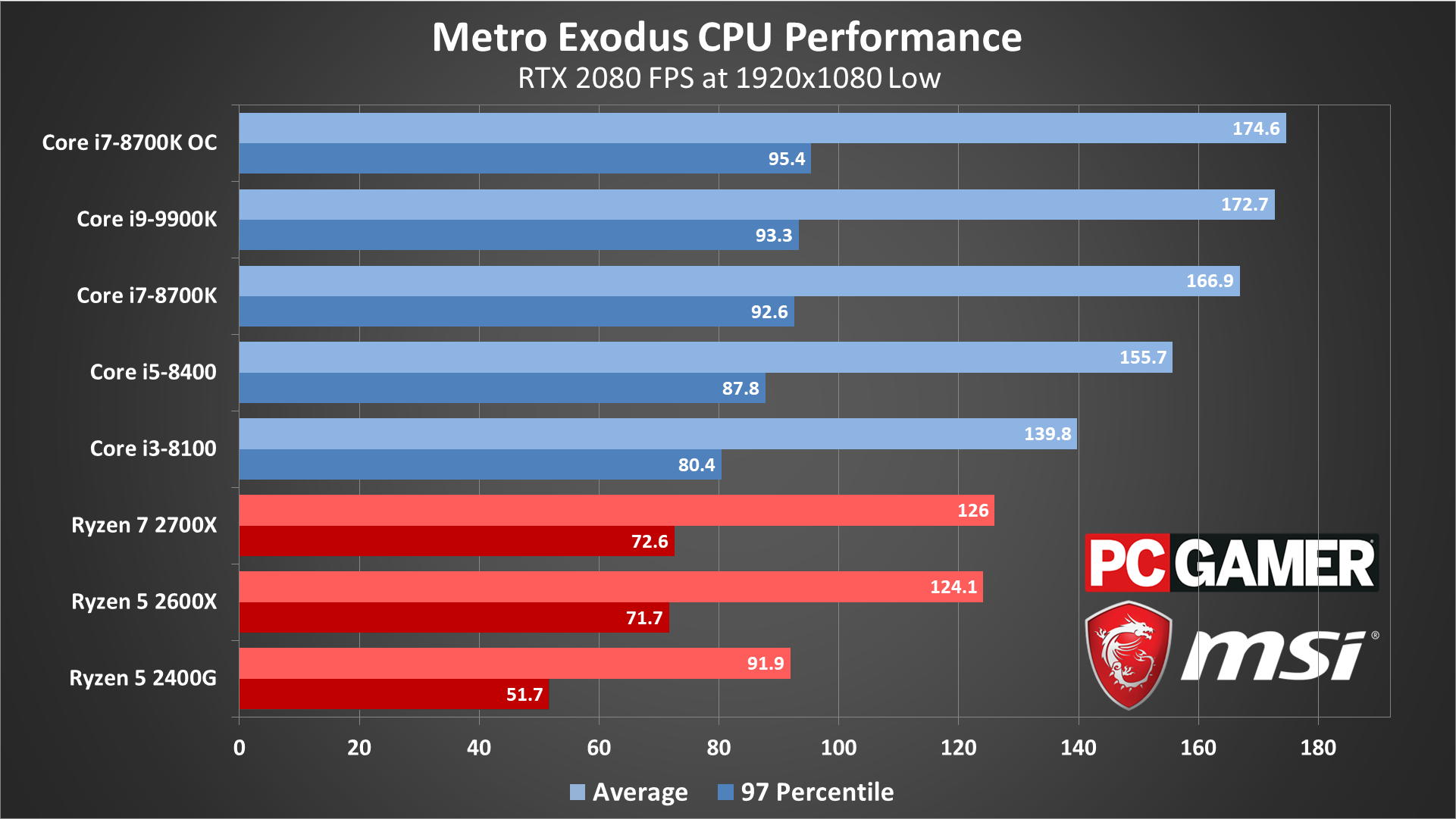
Swipe left/right for additional benchmarks
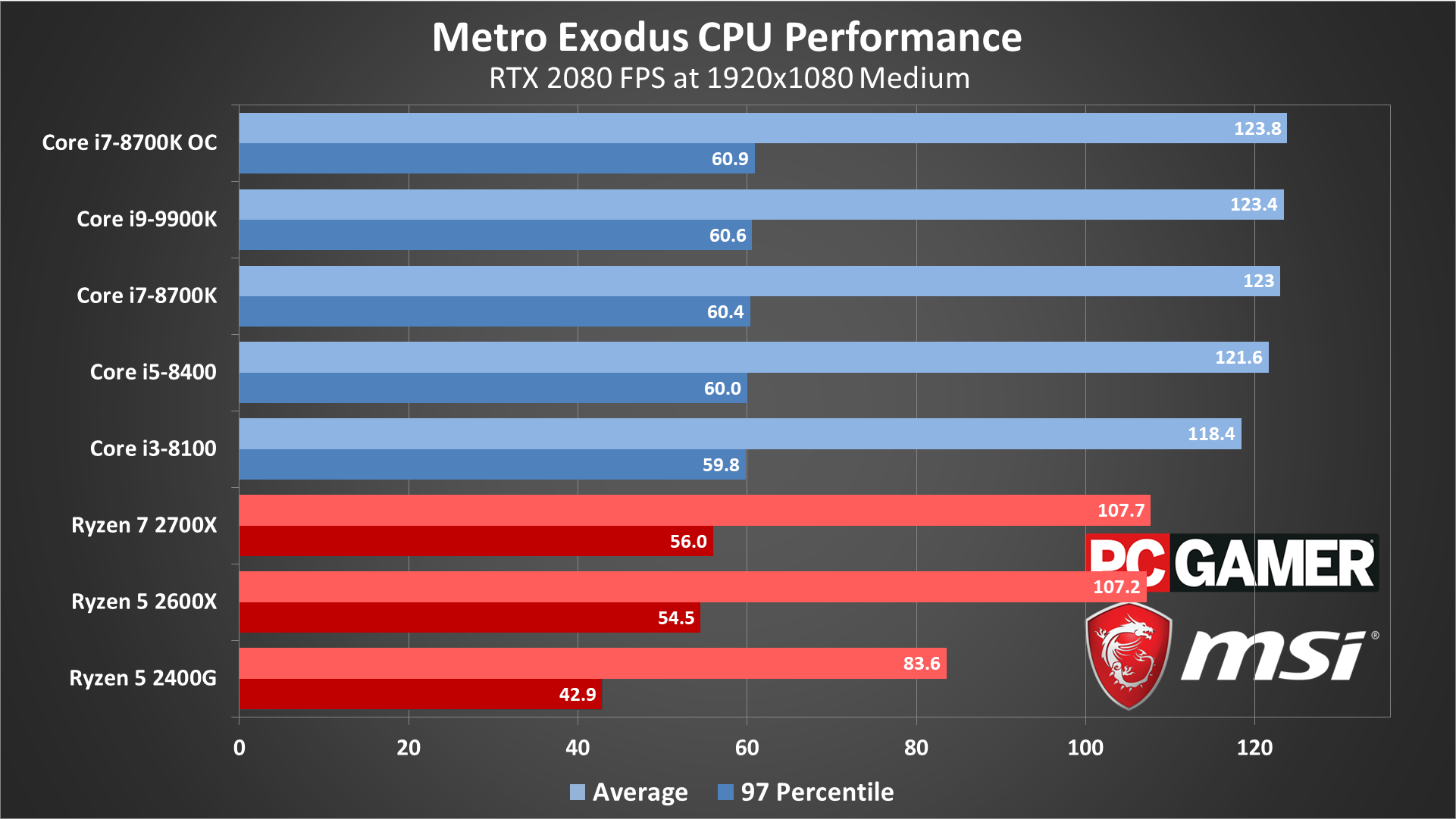
Swipe left/right for additional benchmarks
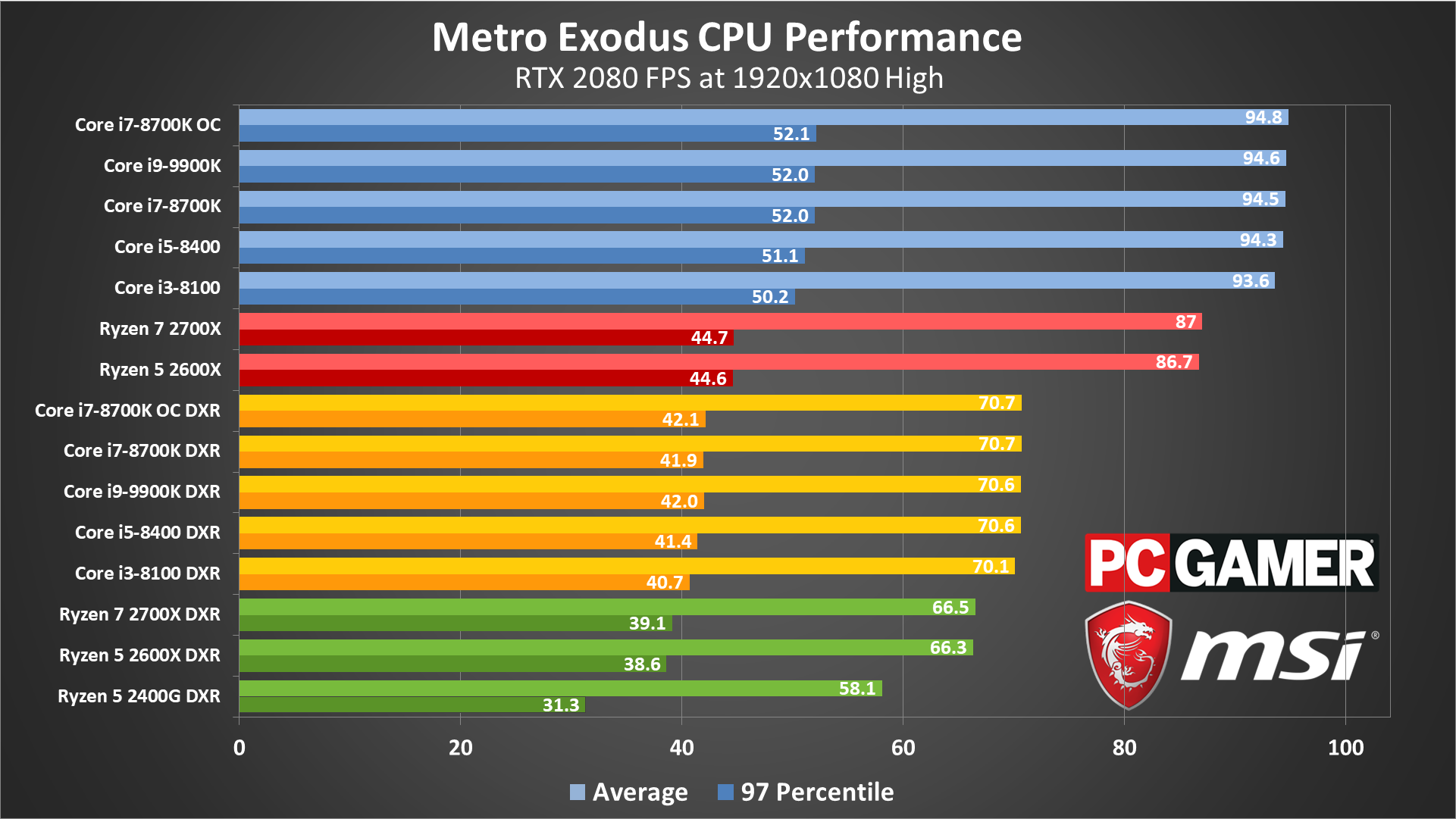
Swipe left/right for additional benchmarks
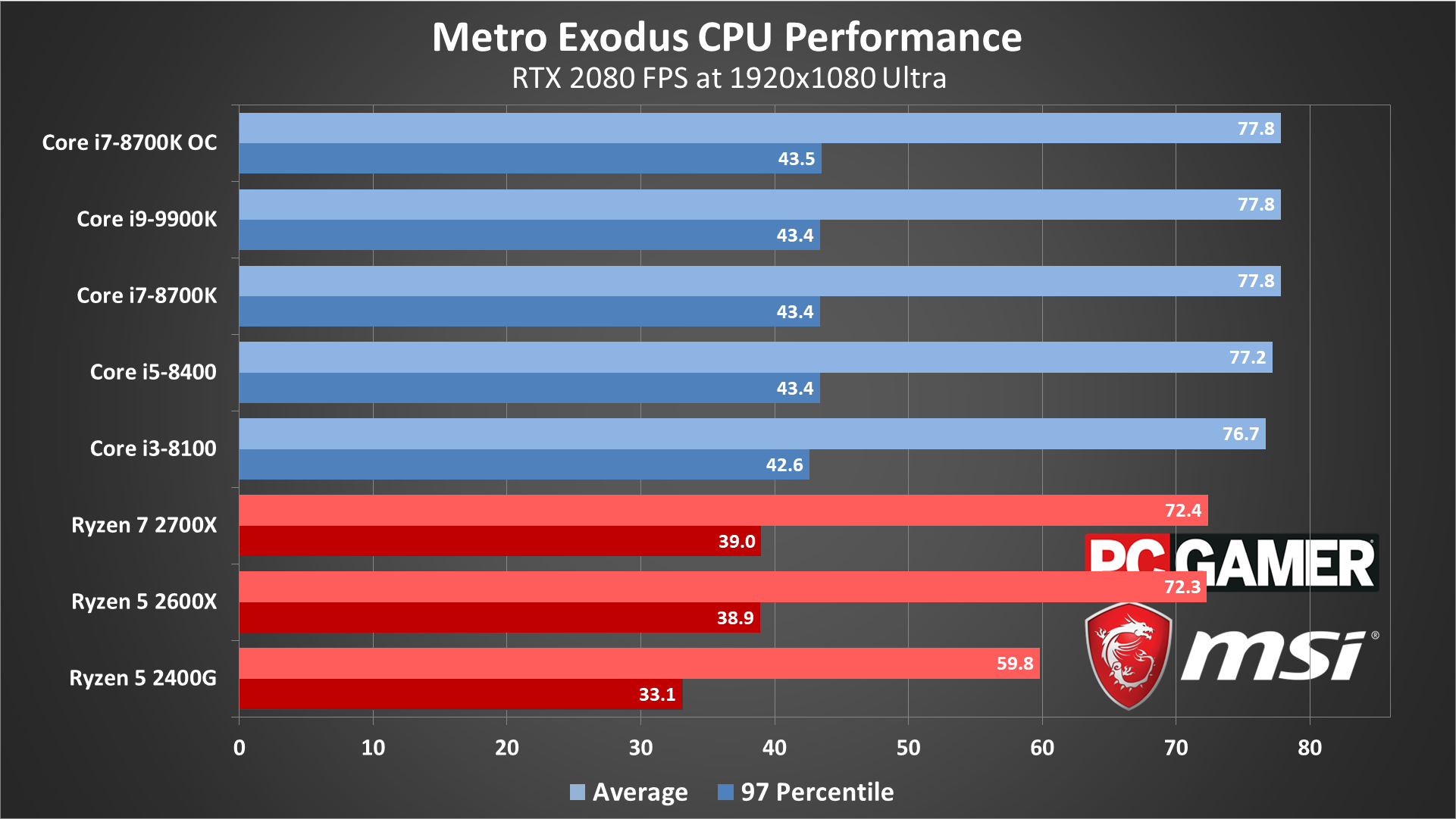
Swipe left/right for additional benchmarks
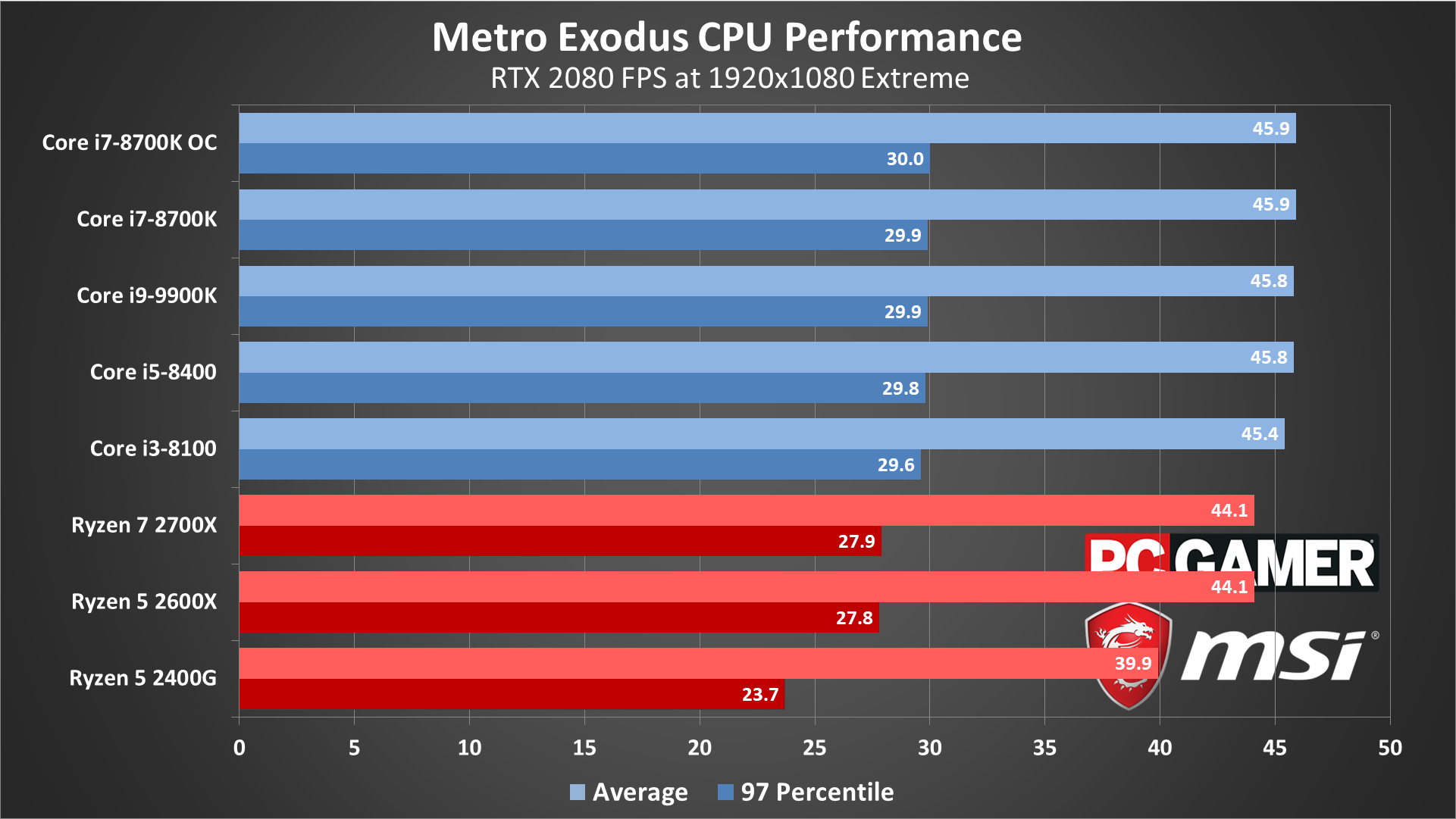
Swipe left/right for additional benchmarks
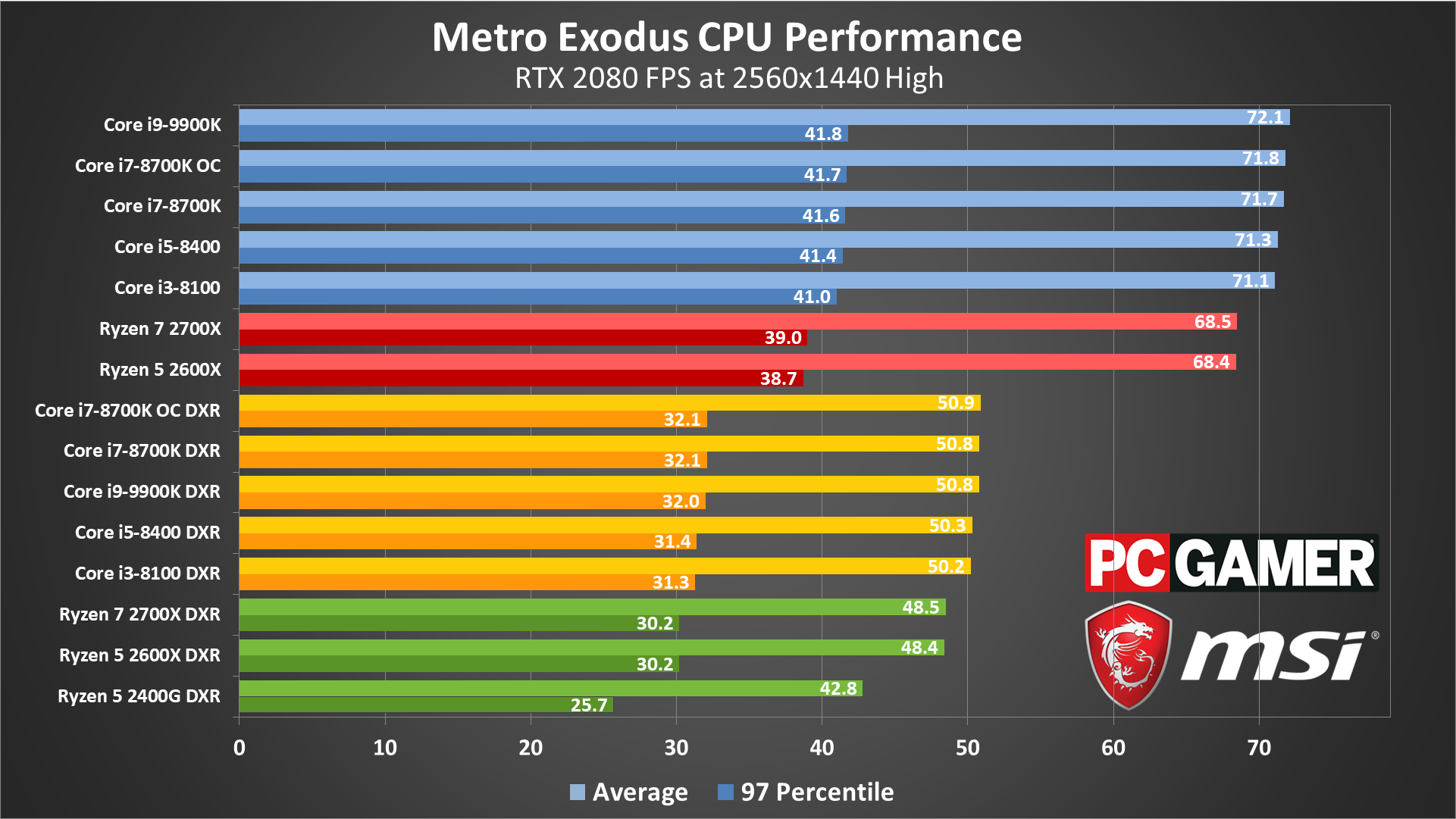
Swipe left/right for additional benchmarks
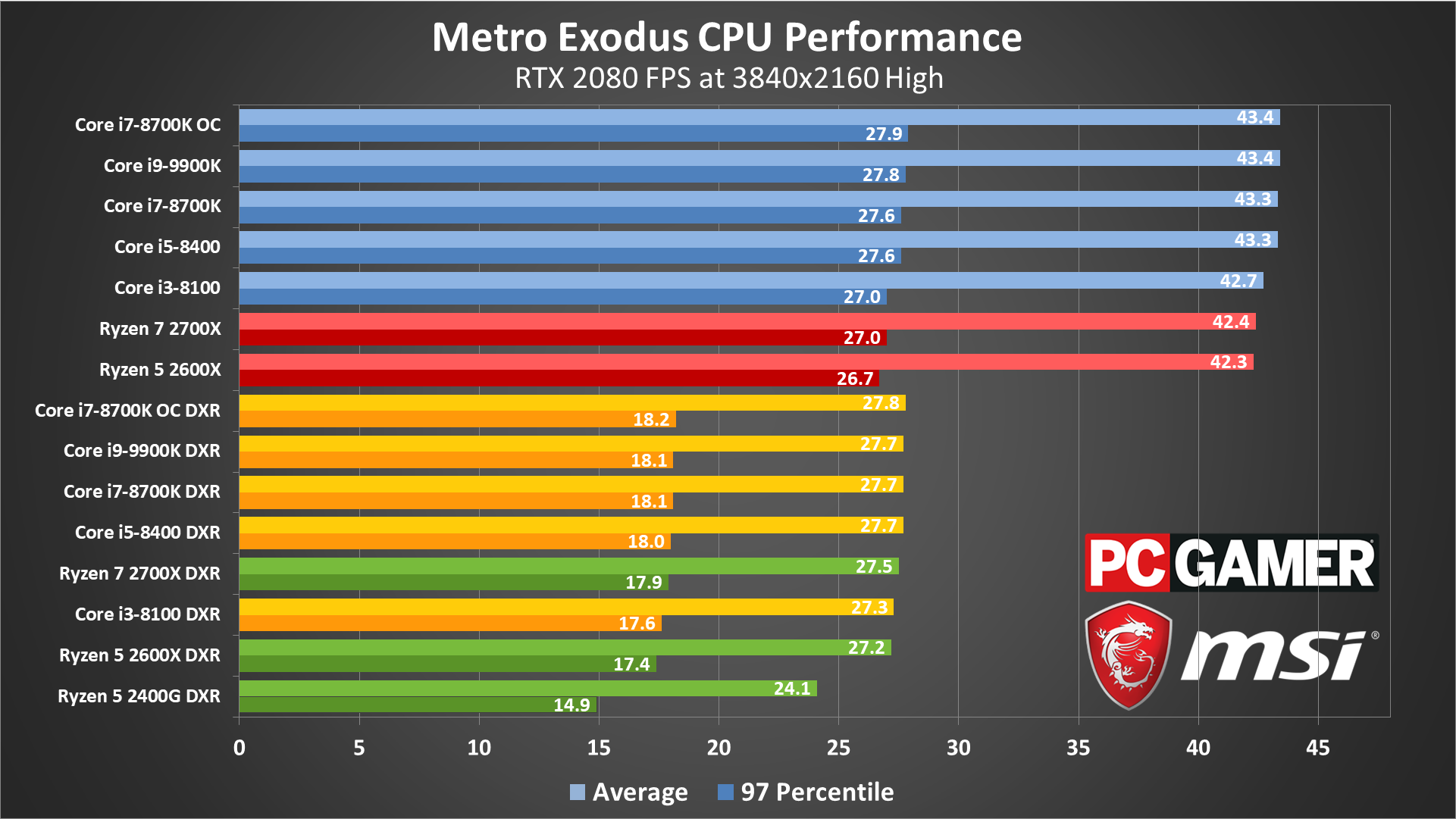
Swipe left/right for additional benchmarks
Interestingly, Intel's CPUs manage to outperform AMD's Ryzen processors pretty much across the range of testing. Clearly having more cores and threads isn't a priority for Metro Exodus. Even the lowly Core i3-8100 beats the Ryzen 7 2700X at 1080p low by 10 percent, and the overclocked i7-8700K is as much as 40 percent faster.
Turn up the settings to 4k high and it's mostly splitting hairs, a 2 percent lead for Intel chips (unless you count the Ryzen 5 2400G). Most likely Metro Exodus is hitting system resources in such a way that cache latencies are more of a factor than in other games. Not being able to leverage AMD's additional CPU cores/threads tends to go hand in hand with that sort of behavior.
Metro Exodus notebook performance
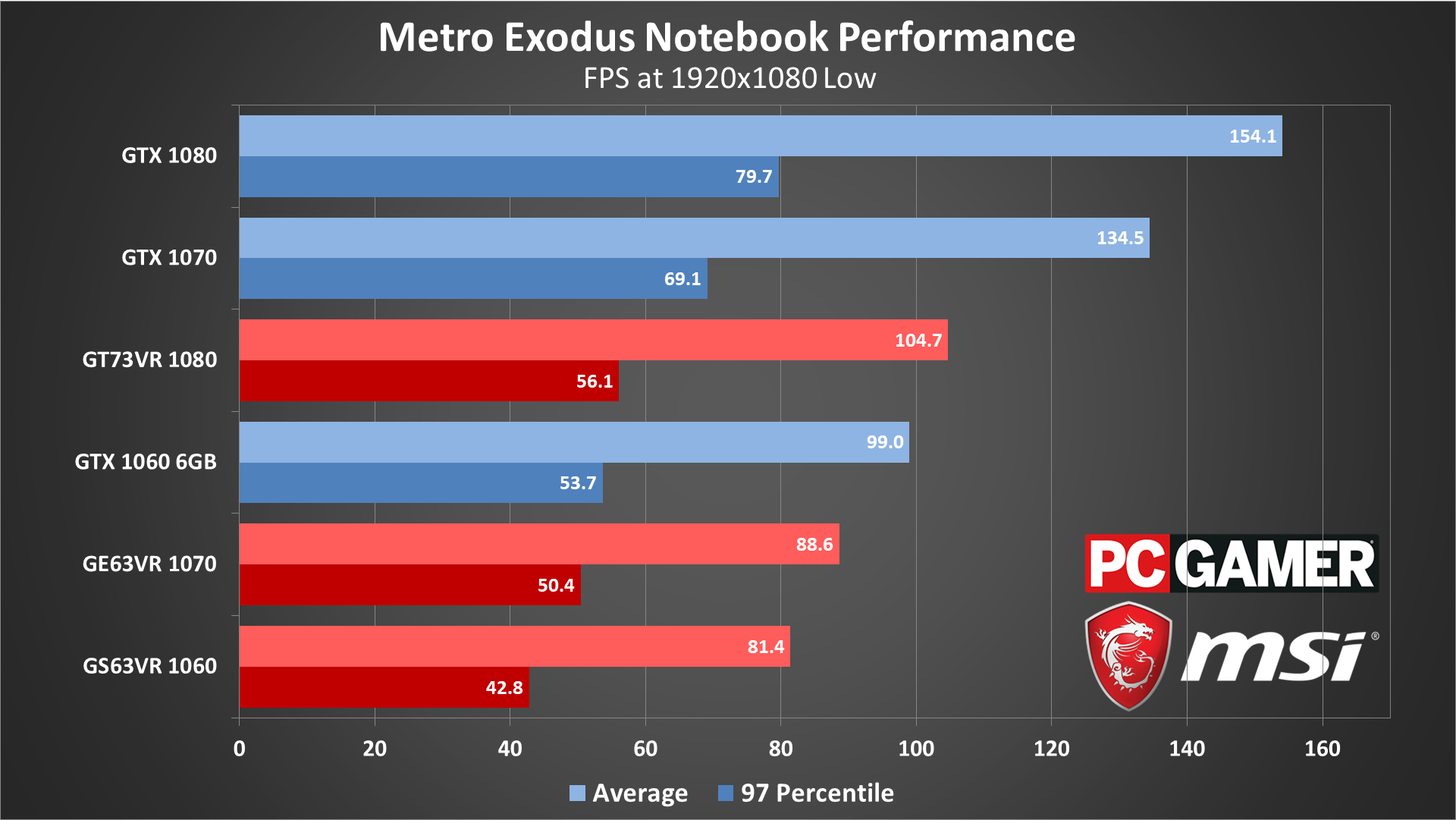
Swipe left/right for additional benchmarks
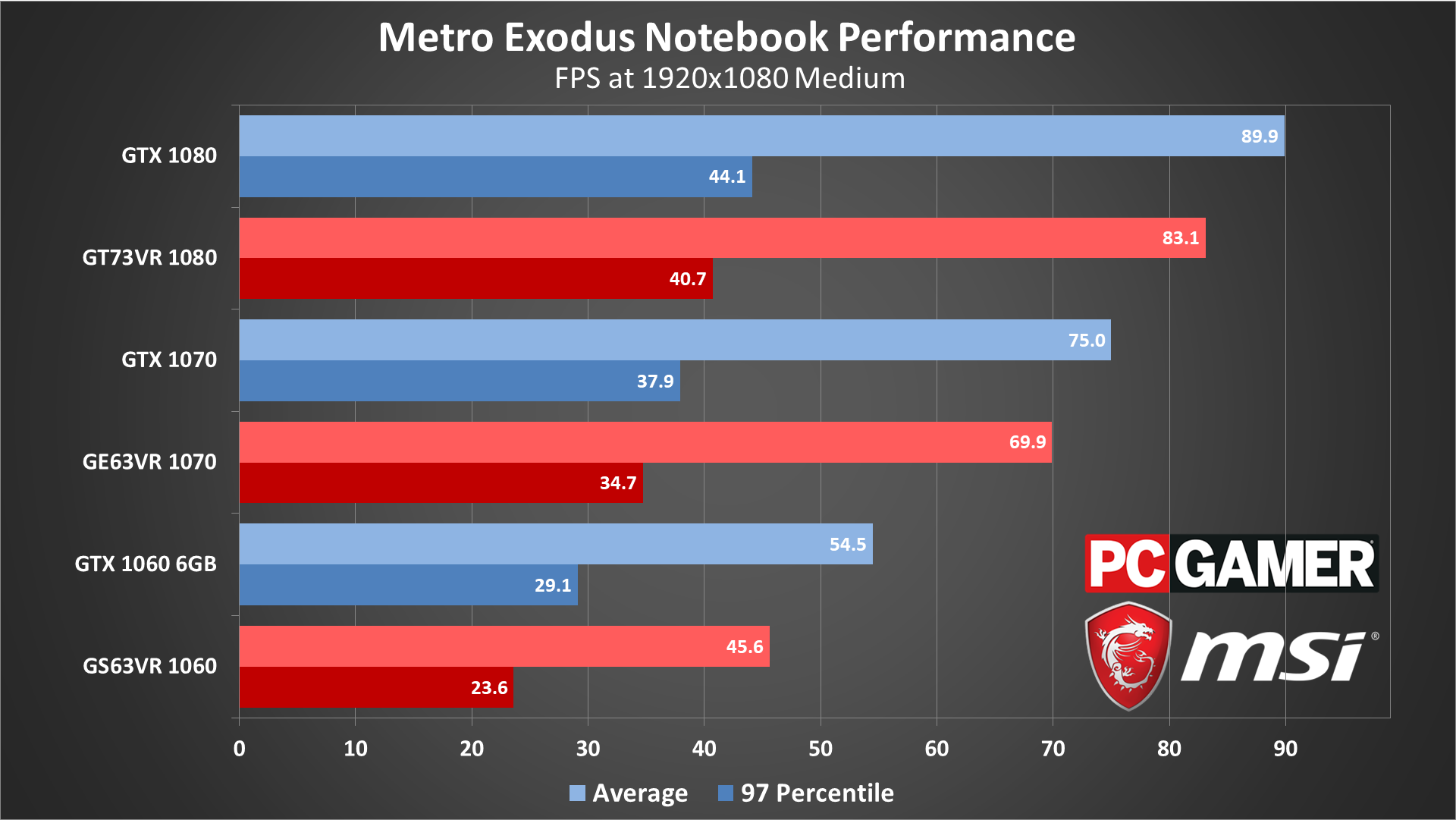
Swipe left/right for additional benchmarks
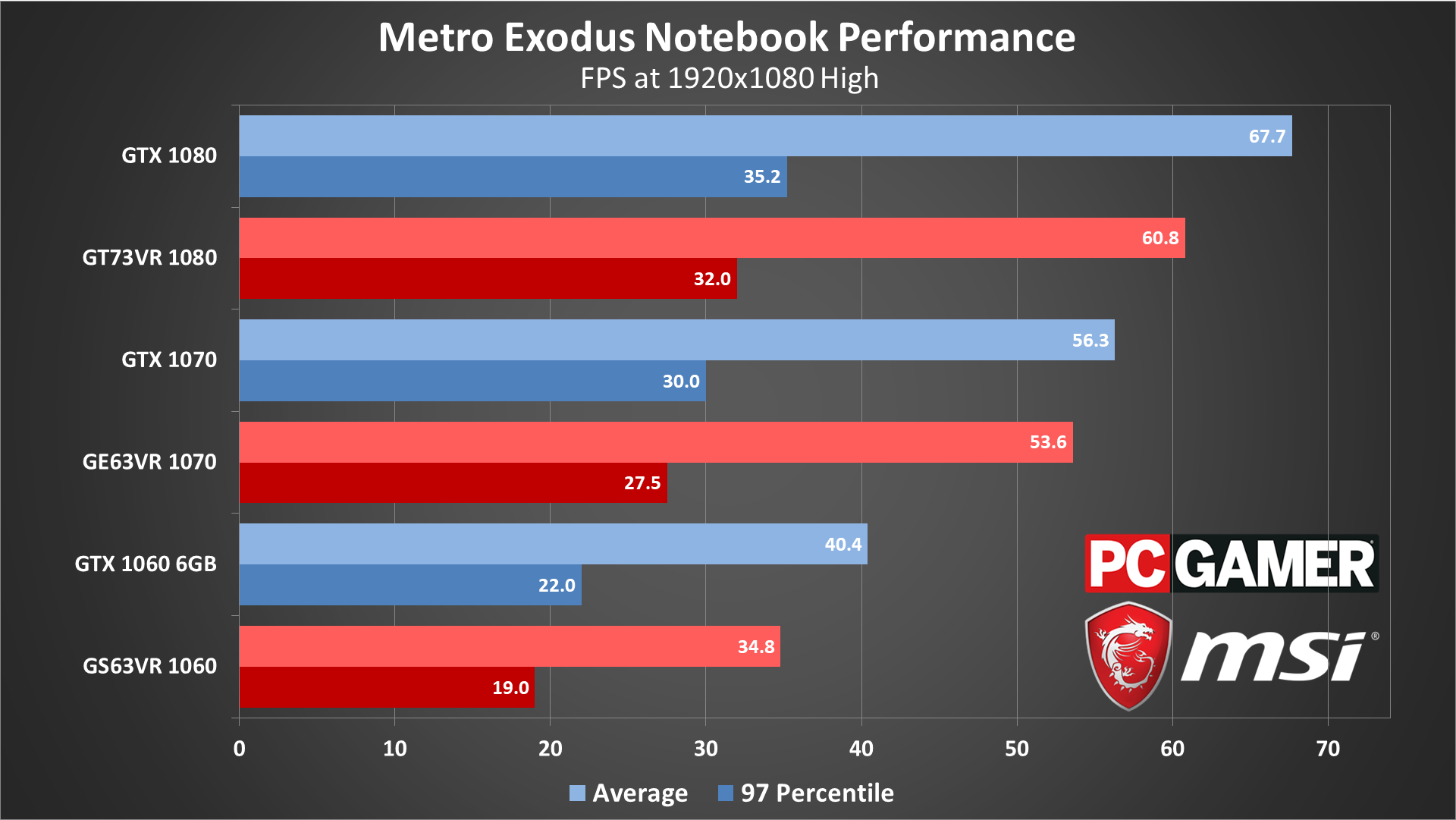
Swipe left/right for additional benchmarks
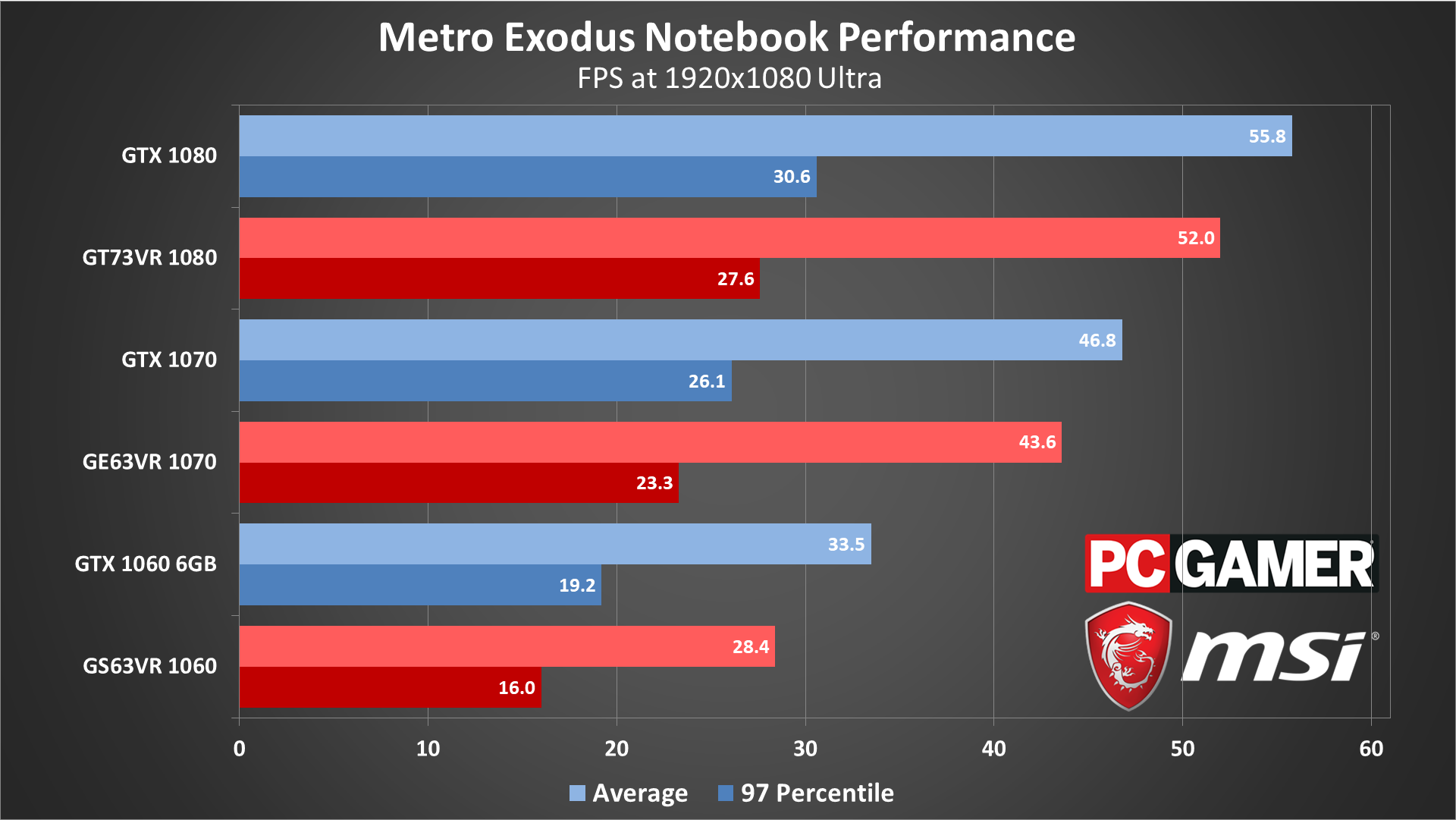
Swipe left/right for additional benchmarks
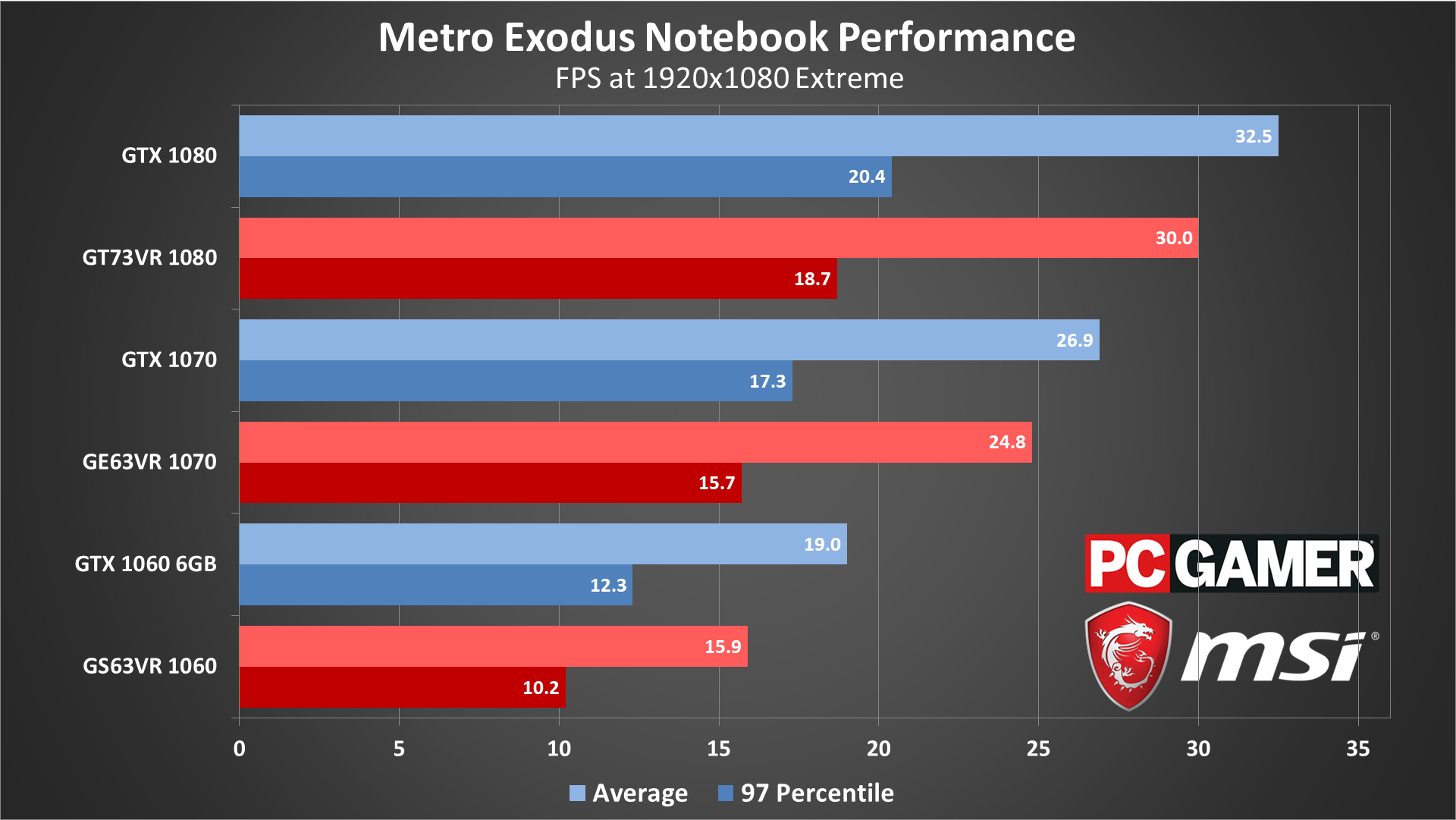
Swipe left/right for additional benchmarks
Given that Metro Exodus isn't particularly CPU limited, our notebook GPU testing looks about as expected. The desktop cards are faster than their mobile counterparts, by about 5-10 percent, at most resolutions. 1080p low is the only exception, where the substantially higher clockspeeds of the desktop CPU appear to pay off, at least compared to the GTX 1070 and 1080 notebooks.
As far as 60fps is concerned, only 1080p low breaks that mark on the three notebooks. Move to 1080p and the normal preset and the GTX 1060 comes up short, and the same goes for the 1070 at 1080p high and above. Ouch. But then, after the earlier GPU results, these mobile performance charts shouldn't be too surprising.
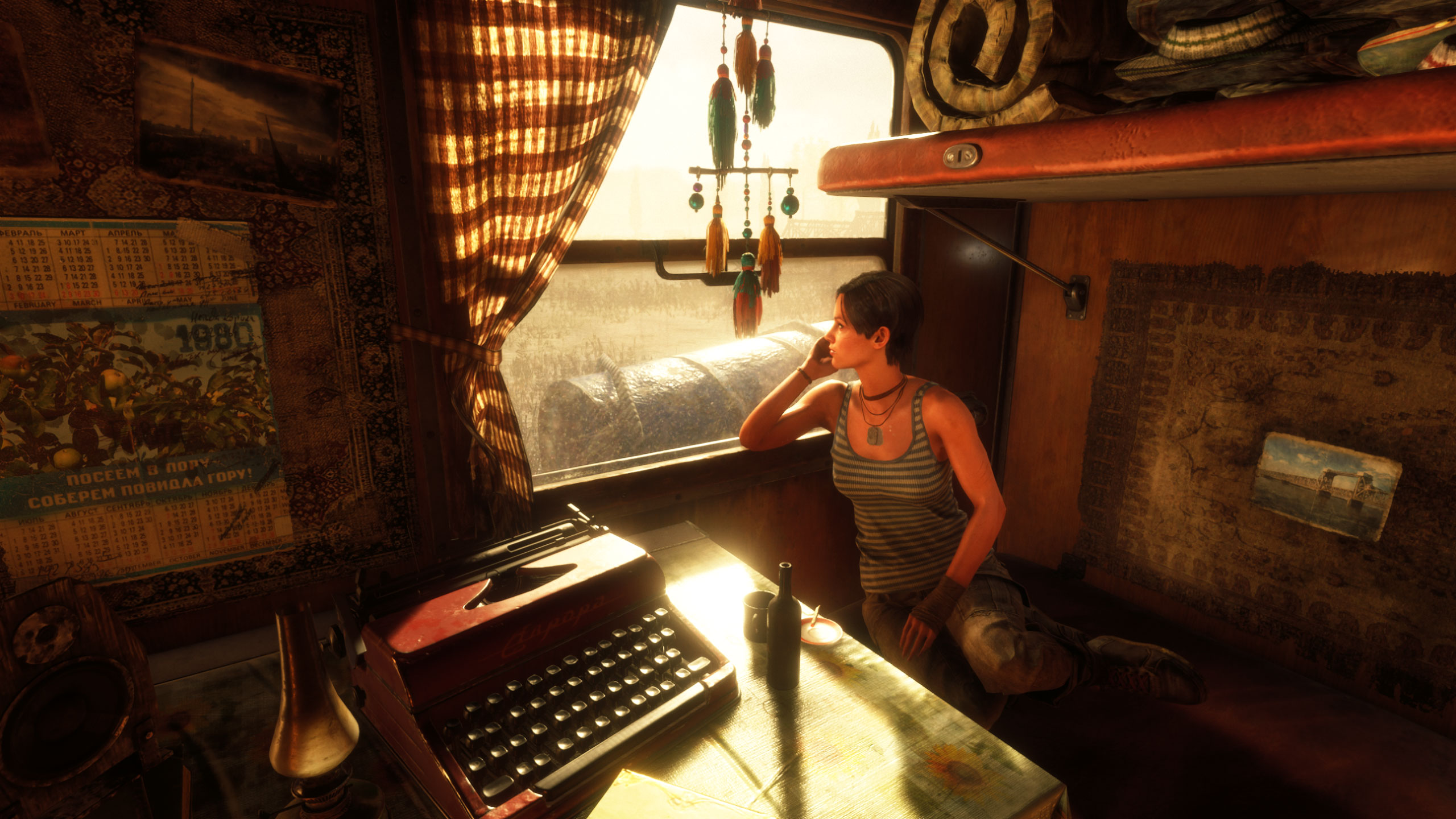
Metro Exodus: carrying the Crysis torch
Desktop PC / motherboards
MSI Z390 MEG Godlike
MSI Z370 Gaming Pro Carbon AC
MSI X470 Gaming M7 AC
MSI B350 Tomahawk
MSI Trident X 9SD-021US
The GPUs
MSI RTX 2080 Ti Duke 11G OC
MSI RTX 2080 Duke 8G OC
MSI RTX 2070 Gaming Z 8G
MSI GTX 1080 Ti Gaming X 11G
MSI GTX 1080 Gaming X 8G
MSI GTX 1070 Ti Gaming 8G
MSI GTX 1070 Gaming X 8G
MSI GTX 1060 Gaming X 6G
MSI GTX 1060 Gaming X 3G
MSI GTX 1050 Ti Gaming X 4G
MSI GTX 1050 Gaming X 2G
MSI RX Vega 64 8G
MSI RX Vega 56 8G
MSI RX 580 Gaming X 8G
MSI RX 570 Gaming X 4G
MSI RX 560 4G Aero ITX
Gaming Notebooks
MSI GT73VR Titan Pro (GTX 1080)
MSI GE63VR Raider (GTX 1070)
MSI GS63VR Stealth Pro (GTX 1060)
I've spent a lot of time kicking the tires of Metro Exodus to see how it runs, as well as how it looks. There are areas where the ray tracing effects look much better, and other areas where you likely wouldn't even notice their presence. The performance hit is still quite steep, and that's just to do ray traced global illumination.
Imagine how much more ray tracing power we'll need to do global illumination, reflections, refractions, shadows, and lighting at the same time. I'm still optimistic for what ray tracing in games will mean in a few years, but I totally get why so many are planning to skip the first round of RTX hardware and wait for the inevitable 7nm sequel—hopefully with two or three times the ray tracing performance.
With my testing of Metro Exodus now complete (and I've retested with the latest updates and drivers, just for good measure), there's not much to say other than anything above the high preset is going to be out of reach of mere mortal PCs. Even with the silliness of a Titan RTX card (which I borrowed from a Falcon Northwest PC that I'm testing), 4k high will dip below 60fps at times. Turn on ray tracing and DLSS and you'll still be looking at 50-55fps averages for the more demanding areas of the game.
There are a few other oddities worth pointing out—like the fact that there's no exclusive fullscreen mode. Metro appears to run fullscreen, but if you capture a screenshot you'll quickly see that it's actually running at your desktop resolution and just stretching whatever lower resolution you select to fill the screen. That's not bad, but it is a bit unusual. Then again, Forza Horizon 4 and Shadow of War do the same thing (as do plenty of other games), and if you're really worried about running at a 'native' 1080p while using a 1440p or 4k display, you can always change the desktop resolution.
One more parting shot at DLSS, running the latest 419.17 drivers and game updates as of Feb. 26, 2019. DLSS looks a lot like doing bicubic upscaling from 2716x1528 to 4k and then applying a soft blur filter in Photoshop. But don't worry, things could improve in the future!
Metro Exodus is very different from the previous games in some ways, and yet from a technical level there are similarities. Metro 2033 and Metro Last Light couldn't run at maximum quality on the hardware at the time, and the same holds for Metro Exodus. It's clearly built to push beyond the capabilities of today's high-end PCs, and even tomorrow's future tech probably won't be able to max out the settings. But come back in five or ten years, and it could end up looking better than ever.
Will gamers be willing to give the Epic Store a shot and upgrade their PC for Metro Exodus? That's probably asking too much, and I suspect many will wait a bit longer before they're willing to jump on this particular train. But if you already own an RTX card and are looking for something to show off its potential, this is at least a better effort than Battlefield 5 (in my book, anyway).
Jarred's love of computers dates back to the dark ages when his dad brought home a DOS 2.3 PC and he left his C-64 behind. He eventually built his first custom PC in 1990 with a 286 12MHz, only to discover it was already woefully outdated when Wing Commander was released a few months later. He holds a BS in Computer Science from Brigham Young University and has been working as a tech journalist since 2004, writing for AnandTech, Maximum PC, and PC Gamer. From the first S3 Virge '3D decelerators' to today's GPUs, Jarred keeps up with all the latest graphics trends and is the one to ask about game performance.


